Introduction
This book will take you on a journey of the lives of four sets of my great grandparents. It tells the story of each using newspaper articles, history, stories, and documentations from their time. Each the great grandparents were born between 1871 and 1891. This was the time of horse powered plows and carriages. Petrol powered trackers and cars were not widely used until 1925 and still then many farmers still used horses to go to town and plow their fields until the 1940s.
My direct ancestors’ names have been bolded in text of this document help identify names of my ancestors.
My great grandparents are outlined in the next four chapters with direct ancestors listed through each generation to myself, Tom Pearson.
Chapter 1 – Grace and Ernest Hofheinz => Edith Hofheinz => Elinor Erk => Tom Pearson
Chapter 2 – William and Minnie Erk => Walter Erk => Elinor Erk => Tom Pearson
Chapter 3 – Richard and Lizzie Phyillaier => Rose Phyillaier => John Pearson => Tom Pearson
Chapter 4 – Lester and Emma Pearson => Lora Pearson => John Pearson => Tom Pearson
Chapter 1
Grace Wasson (b1885) and Ernest Hofheinz (b1877)
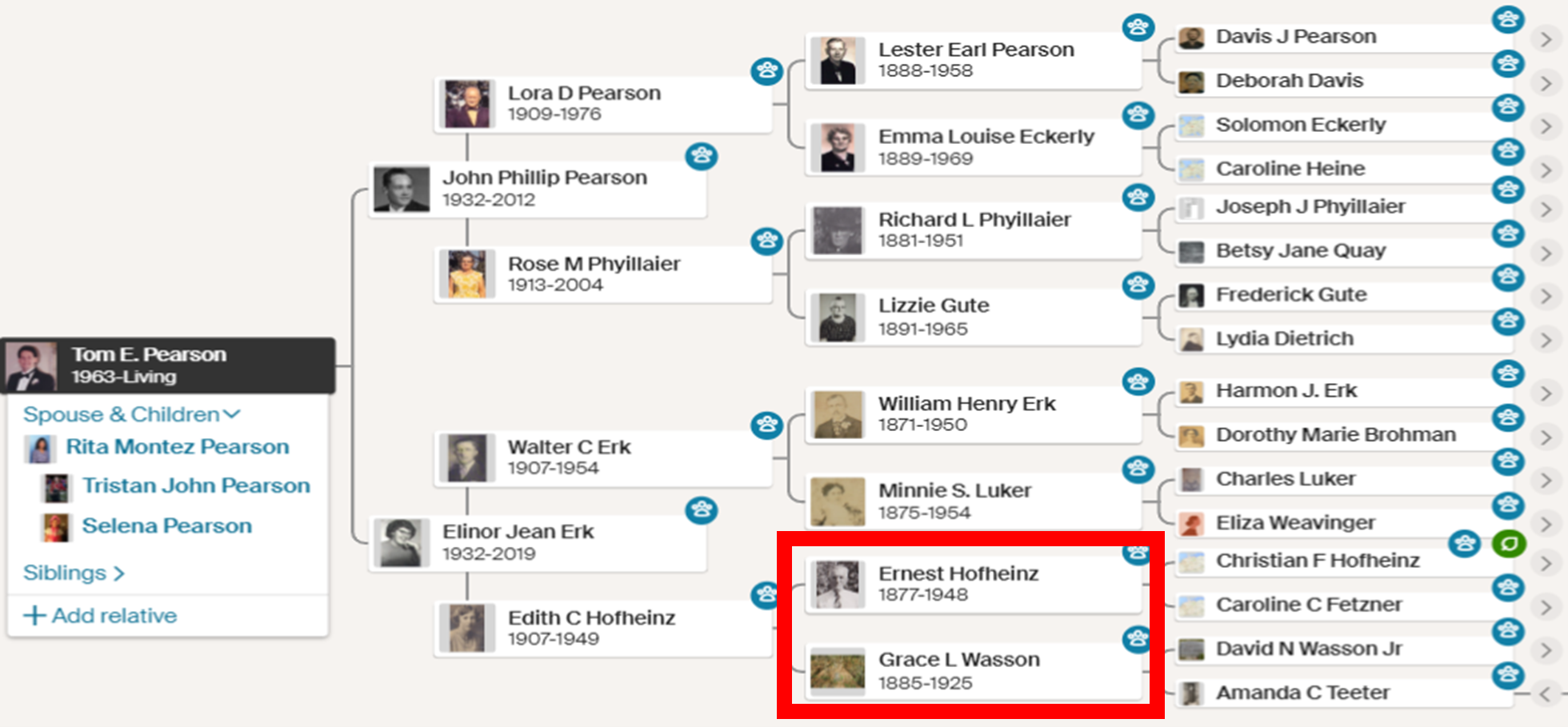
Fig. 1-1 – Tom Pearson’s family tree with his great grandparents Ernest and Grace shown in the red box.
David Wasson Jr.
Grace Wasson lived in Richmond, Indiana where her father David was a laborer and a teamster in a steam tractor factory at Gaar & Scott Company in Richmond, Indiana until 1911. Steam engines and threshing machines were state-of-the-art technology from 1850s until the diesel engine tractors at the turn of the 20th century. They were enormous cast-iron and steel engines weighing in up to ten thousand pounds and were fueled by wood or coal. Grace’s parents, David and Amanda, rented a house at 1130 Butler Street in Richmond, Indiana. They came from farm owning parents near Union City, Indiana. David, being the 11th of 13 children, did not inherit any farmland so he found his livelihood in the factories and farms in and around Richmond area where they raised their two daughters, Bessie and Grace.
The Gaar & Scott Company was sold in 1911 and David lost his job. He continued to work as a farm laborer around the Richmond area for the rest of his life milking cows and delivering milk products to stores around the Richmond area.

Fig 1-2 – 1902 Gaar, Scott Company steam-powered tractor
Before we read more about Grace Wasson (b1885) it is important we read about her 2nd great grandparents Hanna Delay Hole (b1752) and Zachariah Hole (b1752) as they were the founders of Miamisburg, Ohio and one of the first families who settled Cincinnati, Ohio.
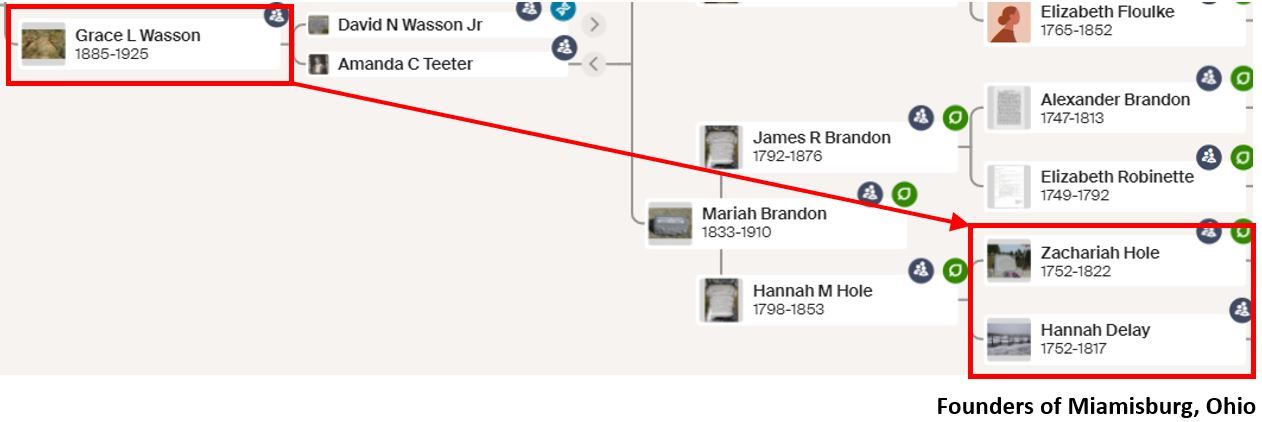
Hannah Delay Hole (b1752) and Zachariah Hole were frontier pioneers
When the American Revolutionary War (1775-1783) was over, the undeveloped Ohio country was American territory. Like many veterans of the war, Virginians, Zachariah (b1752) and Hanna Delay Hole (b1752) brought their family over the mountains into the wilderness north of Kentucky. By January of 1789, the founders of Cincinnati had completed their surveys and plot maps. Among the first few families to buy their land was that of Zachariah and Hannah Hole with their first five children. Hannah Hole’s family and Zachariah's brothers, Daniel, John, and William, were one of the first settlers who made up a large part of Cincinnati's civilian population in 1789. They pooled their resources, labor, and land to construct Losantiville Station among the hardwood forests along the banks of the Ohio where now sits the Cincinnati Reds baseball stadium. A station was a wooden stockade built to house several families until it was safe to go out and establish individual homesteads.
At the same time, on a hill a few hundred yards away, the new US government was building Fort Washington, a major regional army base on the Ohio River. While the British had withdrawn after the Revolutionary War, they were still encouraging Indian raids on settlers and outposts throughout the Ohio country. Braves under Chief Blue Jacket of the Shawnee and Chief Little Turtle of the Miami tribe were concerned about the future of their hunting grounds. Until the victory at the Battle of Fallen Timbers in 1794 and the Treaty of Greenville in 1795, it was unsafe for individual families to settle far from established forts in Ohio.
Hole’s station - First homestead in Miamisburg, Ohio.
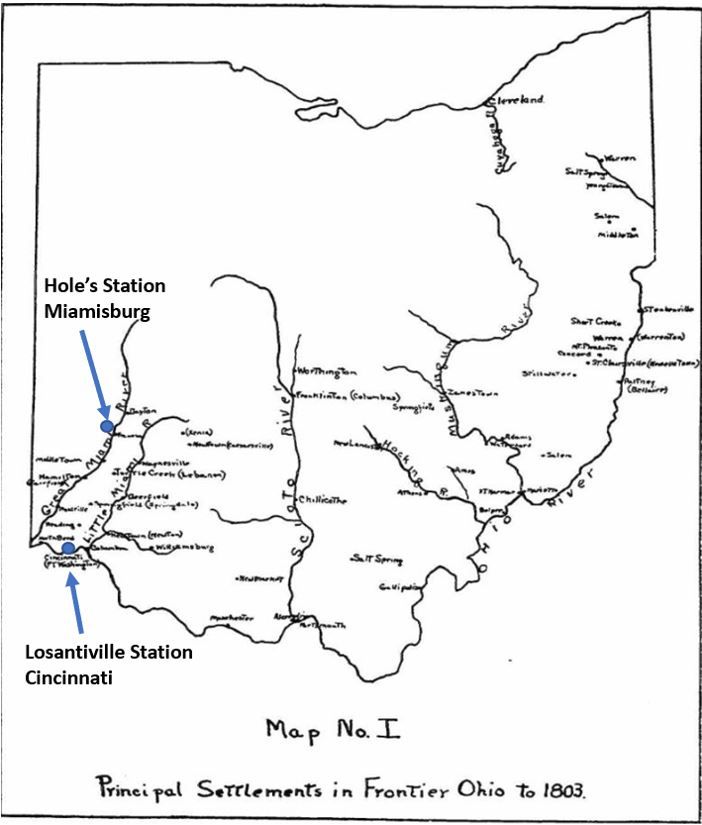
By 1797, Zachariah and Hannah had left the protection of Fort Washington to go 40 miles up the Great Miami River and establish Hole's Station at the future site of Miamisburg, Ohio. Hannah Hole (b1752), my 7th generation maternal mother and her family were the first settlers and founders of Miamisburg 220 years ago when they built Hole station. Their children and grandchildren went on to establish farms in the Miami Valley area near Versailles, Ohio and Union City, Indiana until their 2nd great granddaughter, Grace Wasson, was born in Richmond, Indiana in 1885.
Grace Wasson (b1885)
Grace Wasson (b1885) was the second and youngest of David and Amanda children. In 1903 at the age of 17, Grace married an older Ernest Hofheinz (b1877) that was 25 years old. He worked as a clerk at a grocery store in Richmond, Indiana. Ernest’s parents were part of the German Lutheran migration to Richmond in 1864 and was one of the first of their kind to settle in the city of Richmond. Where did Grace and Ernest meet? She was not from the Lutheran community and did not have recent German ancestors. Did Grace shop at the grocery store where Ernest worked?
The 1903 Richmond directory shows Grace living with her mother and father on Butler street in Richmond and working as a seamstress at age 17. In the early 1900s only 11% of all children after the age of 13 went on to high school. Children grew up early in those days, and Grace was no different, she married at 17 in July 1903. Six months later, Ernest and Grace had their first son Ralph. Their second son came two years later in 1905 (Herbert), and in 1907 Edith Hofheinz, my grandmother, was born. Ernest and Grace lived at 712 South 13th Street Richmond, Indiana in 1907 and he was listed in the Richmond directory as driver for a grocery store while she did the housekeeping and childcaring. He likely drove a team of horses for the grocery store as in those days cars and trucks were rare and just beginning to make the transition from horse drawn wagons and carriages.
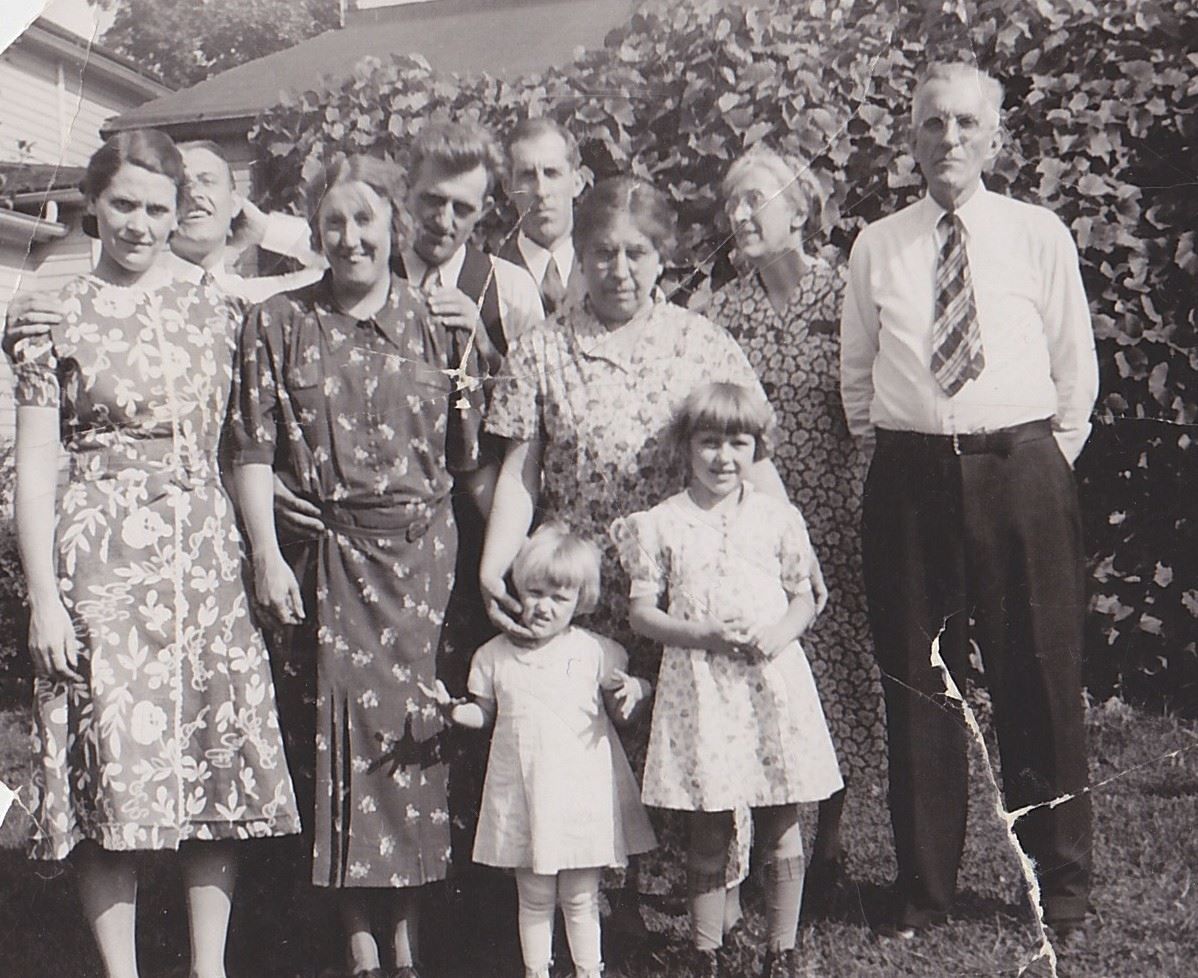
Fire at Mrs. Grace Hofheinz House
On July 1st, 1908, the Richmond newspaper reported Grace caused a fire alarm to be turned on from the corner of Grant and Sheridan Street however the neighbors extinguished the flames before the firemen with their clumsy ladder horse could make it to the house. It seems that their horse slipped and fell on the Richmond Avenue bridge over the Whitewater River causing delay.
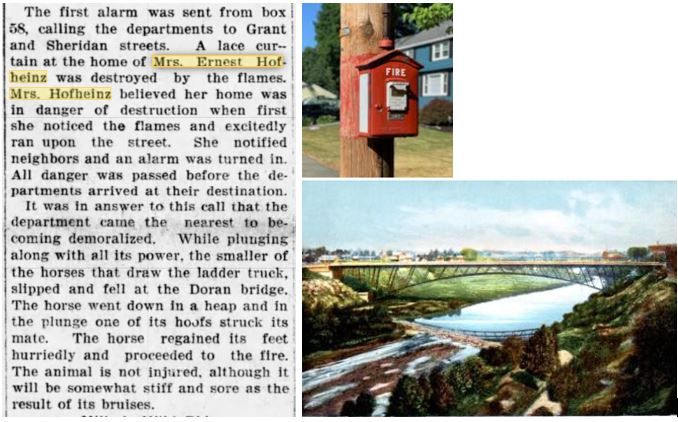
Fig. 1-3 – Richmond Item reporting fire at Grace’s home and Doran Bridge stretching across the East Fork of the Whitewater River on Richmond Avenue. A typical fire alarm box
This is the first story of many that shows Grace Wasson Hofheinz was seeking help and attention to her problems. A month later Grace attempted suicide by ingesting carbolic acid which is a common household disinfectant cleaner. She did not take enough to kill herself, however she must have been calling out for help with her struggles with depression. Earnest worked at the Jones hardware company at the time as a simple laborer. Grace’s sister and parents had moved on to a farm on Union Pike soon after this episode and were no longer neighbors.
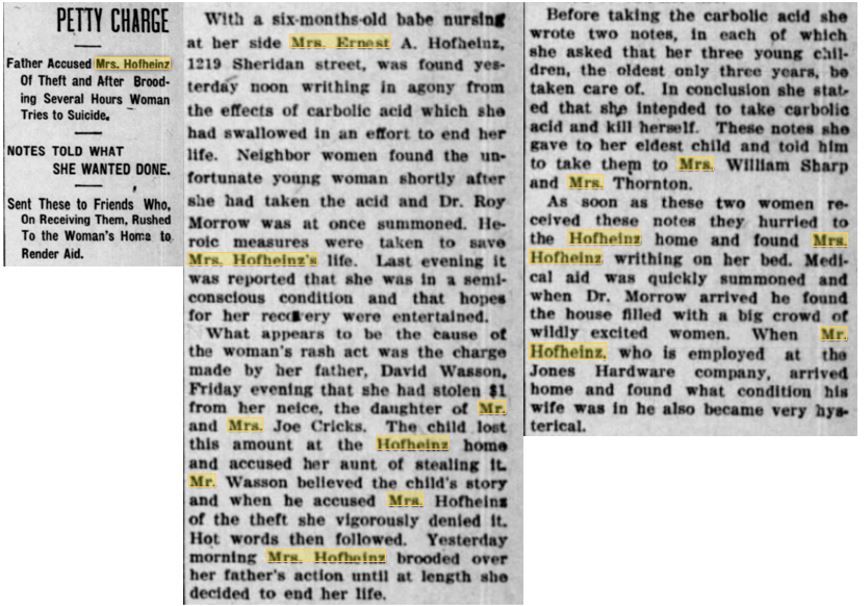
Fig. 1-5 - Aug 2nd, 1908, Grace Wasson suicide attempt in the Richmond Item
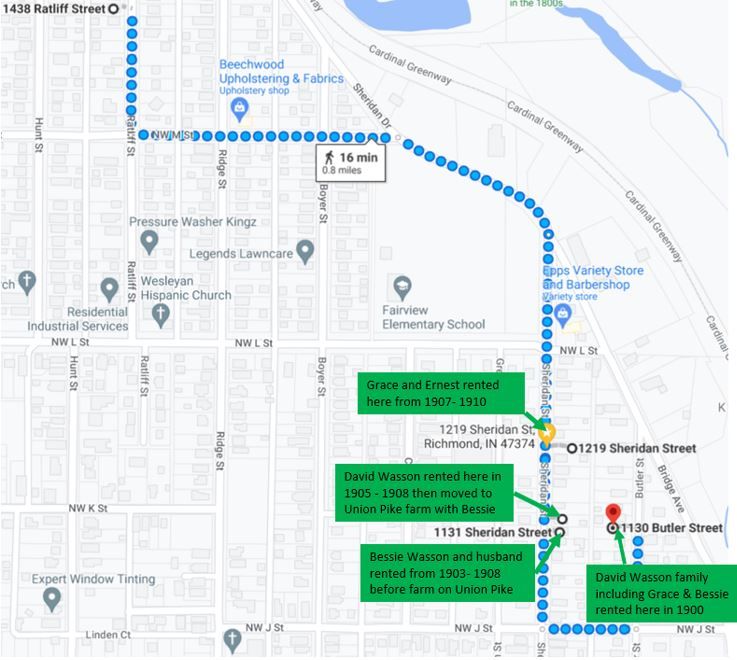
Fig. 1-4 – Homes in Richmond where Grace Wasson and parents rented from 1900-1910
After the attempted suicide incident, Ernest started working at the Champion Roller Mills. The mill was steam powered factory that crushed and processed grain such as wheat grown from the local farmers. The Richmond Baking Company was set up alongside to bake the flour to make breads and crackers. The mill stayed in operation until 1912 and was located on Fort Wayne Avenue under the Highway 27 overpass.
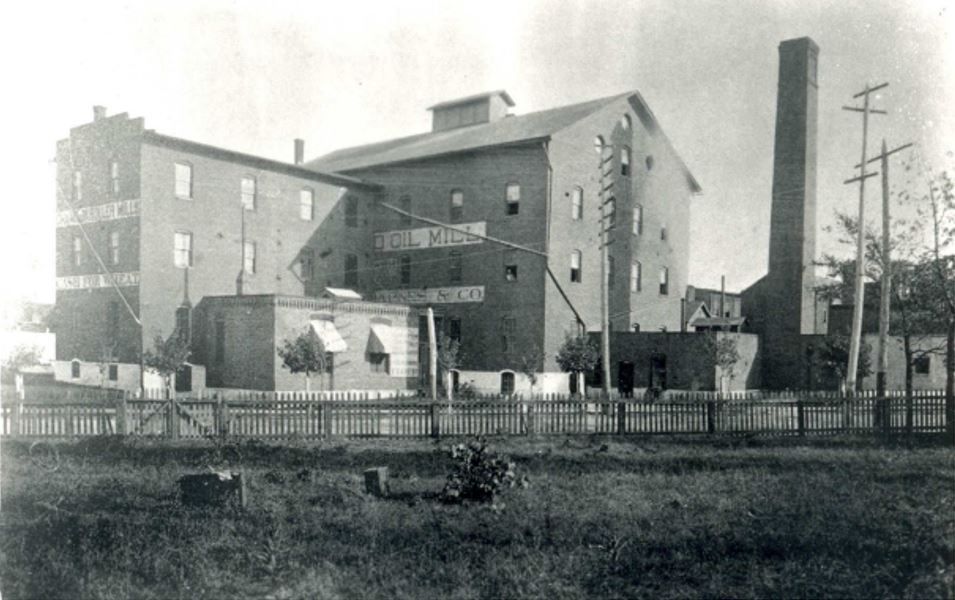
Fig. 1-6 Picture of Champion Roller Mill
Grace Elopes with Walter Elstro
Trouble followed the couple soon after Grace suicidal attempt in the evening in September 1909. Grace ran away with Walter Elstro, a 19-year-old man who happened to be Ernest Hofheinz sister’s stepson. Grace and Walter were gone for 4 days and on her return, Ernest threw her out from his home and put the wayward wife in the custody of the Home for Friendless Women until she was released into the custody of her father David Wasson. Two months later, Ernest filed in Richmond court for divorce and custody of the 3 children on grounds of adulty and child abandonment. It appears from the divorce hearings, the affair Grace was having with Walter Elstro was going on for over 9 months.
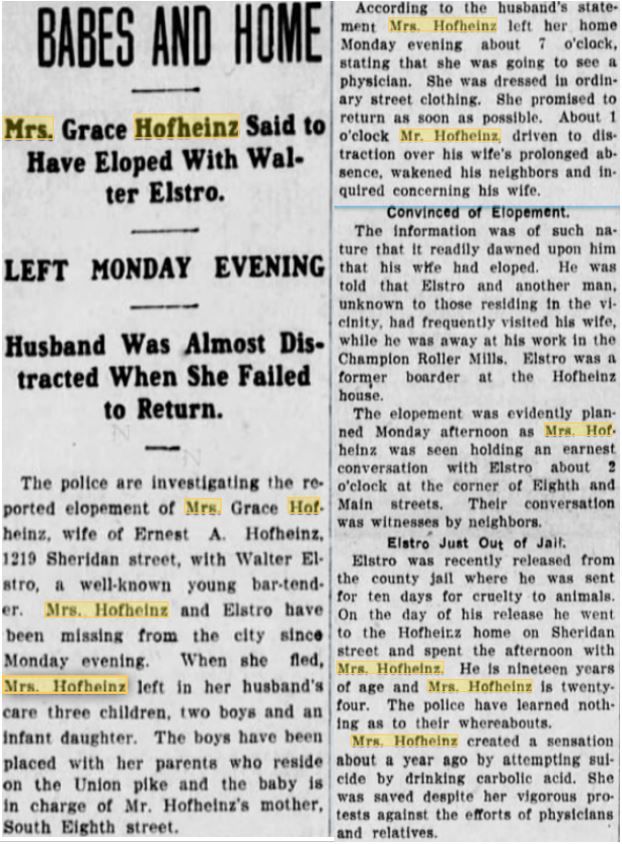
Fig. 1-7 - On Sept 29, 1909, Grace elopes with Elstro Walter and leaves her babies at home.
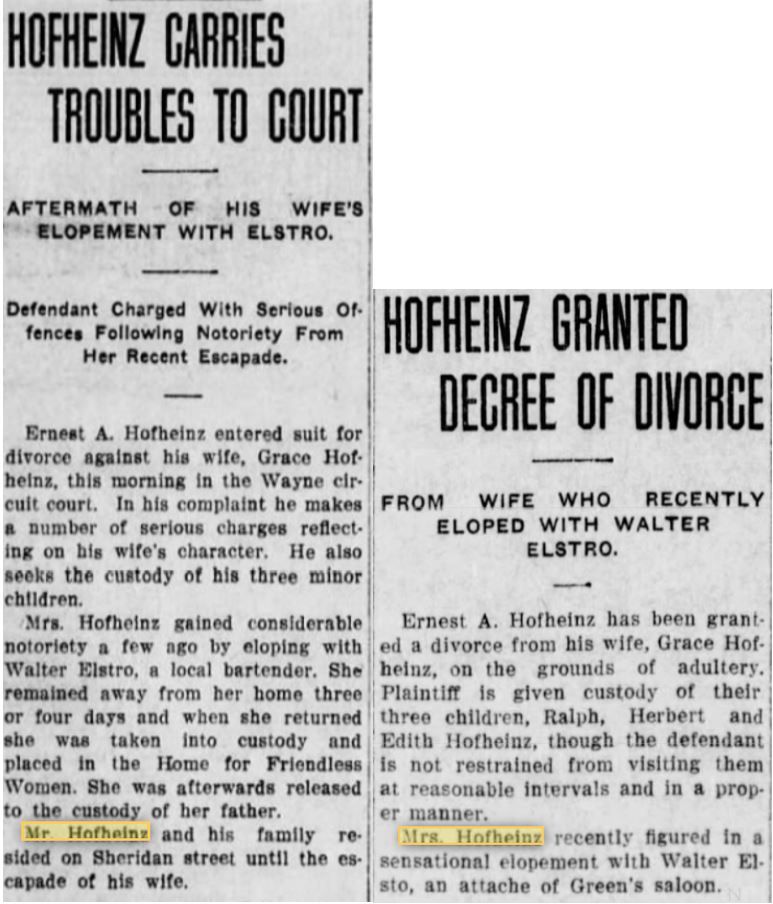
Figure 1-8 – Divorce Court
Cupid Strikes
In March 2010, five months after her divorce, Grace answers a want add in the newspaper for a wife that Clarence Lamb placed in the paper. The couple met and within 5 days they were married and on their honeymoon. Did Clarence know who he was marrying? A mother of 3 children that she abandoned and later lost custody when she eloped with Walter Elstro on an escapade for four days. A depressed suicidal woman who is desperate to get out of her father’s house. A woman that had developed syphilis likely from her escapades.
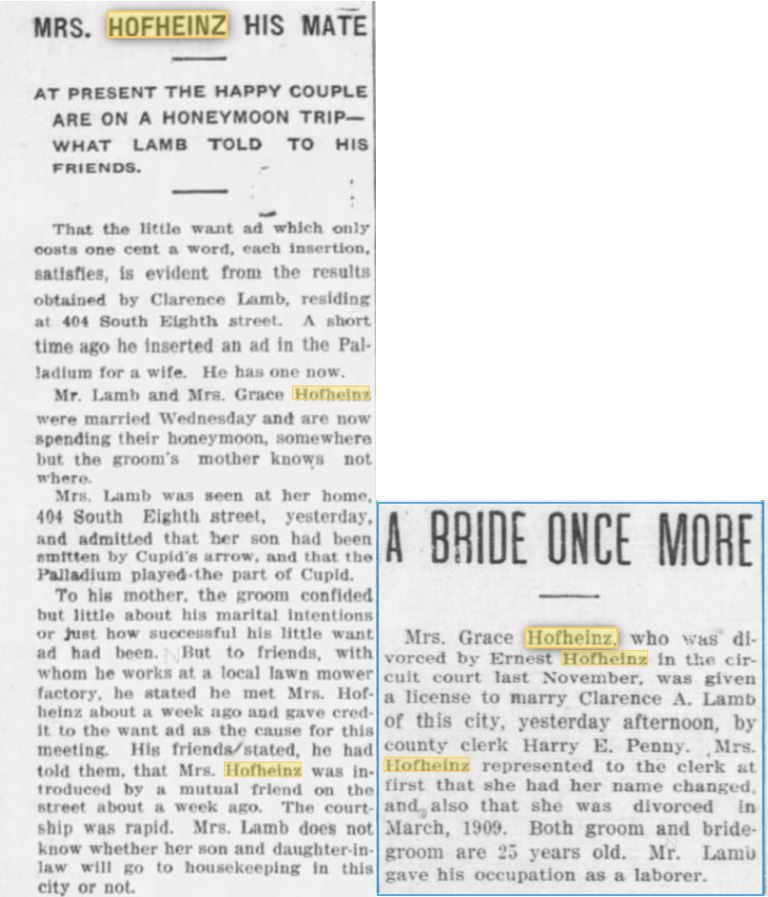
Fig. 1-9 – March 3, 1910, happy couple on honeymoon trip. A bride once more
After their quick marriage and honeymoon, Clarence separated from Grace six months later. Grace kept her last name, Mrs. Grace Lamb, indicating that even after separated Clarence must have still supported her in some manner. Her father David Wasson died of a heart attack in at age 53 on October 1911 while delivering buttermilk to an establishment on North E and 9thstreet. The paper listed that Grace was attending high school however she was 24 years old. Likely at that time she was living with her parents after separation from Clarence Lamb. After David Wasson’s death his wife worked and lived as a servant at different families in Richmond until her death at 80 years old. She outlived both her daughters.
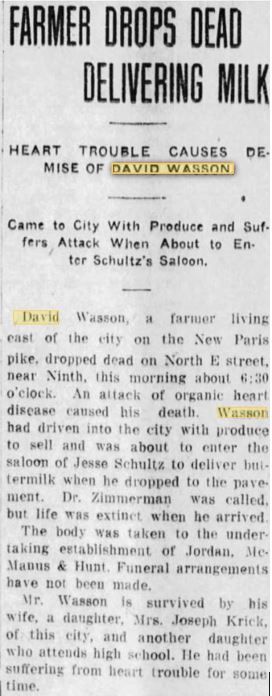
Figure 1-10 – Oct 21st, 1911- David Wasson drops dead
In 1918, Grace Lamb was a trimmer for horse drawn coaches living at 334 Richmond Avenue. In 1921, she was listed as a clerk for a department store Knollenberg in Richmond and lived at 202 ½ North 8th Street.
Grace divorced then remarried after 3 days
In the meantime, Clarence Lamb went into the army during WW1 for two years from December 1917 until February 1919 based most of the time in Fort Worth, Texas as a cook. He did not serve any action in the European theater. On leave from the army in August 1918, he came back to Richmond and filed for divorce from Grace. They have been separated for 7 years however he didn’t file for divorce until August 1918. What is more surprising he then remarried her 3 days after the divorce was granted in October. Why did he do this? Was there a legal issue that needed resolved? The WW1 draft categories allowed married men with dependent spouses to be temporarily deferred from service however Clarence still got drafted into the Army in December 1917.

Fig. 1-11 – Aug 5th, 1918, Richmond Item - Clarence Lamb filed for divorce from Grace Lamb
Florida State Hospital
Grace and Clarence remarried and lived for the next three years in Richmond together with him working on a farm and Grace doing laundry for a private household. During that time Grace issue with syphilis must have gotten worst with paralysis and mental illness and they left the cold weather in Indiana for warmer weather. In October 1922, when the weather started getting colder, the couple moved to Florida. Who or what was there for them? Grace never contacted her family after she moved and she left her teenage children in Richmond with their father and aunts. When she arrived, Grace was immediately installed as a patient at the Florida State Hospital near Tallahassee to care for her condition. In those days hospitals were not places for healing, rather they were places to care for the mentally ill and the dying. This mental hospital was notorious for mistreatment of their patients.
Grace's Death
After two years at the Florida State Hospital, in January 1925, Grace died at the age of 40 with paralysis due to secondary syphilis or maybe the mercury poisoning that comes from treatment. Her death certificate said she died of “Paresis”, inflammation of the brain in the later stages of syphilis, causing progressive dementia and paralysis. She was at the hospital from October 1922 until her death in January 1925 and buried at the hospital cemetery the next day without ceremony. For over two years Grace was in the lonely hospital without family, most likely without consent, likely mistreated by hospital employees, dying of a disease that today is cured within two weeks with simple antibiotics. Clarence Lamb reported on her death certificate that she was born in Alabama, and that he did not know who her parents are or where they lived.
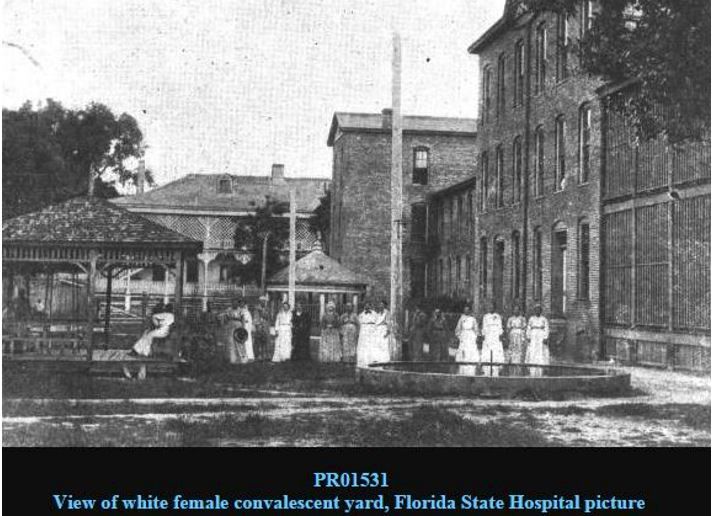
Fig 1-12 Florida State Hospital where Grace Wasson died at age 40
While Grace was in the Florida State mental hospital, Clarence went on to live his life in Arcadia, Florida, 400 miles south, fathering a child from a teenage mother in 1924, a year before his wife, Grace had passed away. After Grace’s death in 1925, Clarence married his teenage bride and named his second child Grace. Years later the death certificate of Walter Elstro, who eloped with Grace for those infamous 4 days in 1909, died in 1941 at the age of 50 from secondary stages of syphilis. His wife died 3 years before him, also from syphilis. You can see their death certificates in the figures below.
Ernest remarries and has a daughter
But what about Ernest Hofheinz, my great grandfather, where did his life go from here? Ernest married Stella Stanton at the age of 50 in 1927. He was likely compelled to because six months later they had a child Mary Hofheinz. Ernest continued to work as a laborer the rest of his life as a baker at the Richmond Baking Company. After 7 years of marriage, he divorced his wife and then moved back into his childhood home at 316 South 9thstreet with his sisters.
The Richmond Baking company Ernest worked at was expanding in 1916 by buying the old Gaar & Scott Company office and the two vacant lots on North 6th street. When they finished building the 5-story factory they hired Ernest as a baker where he worked for many years.
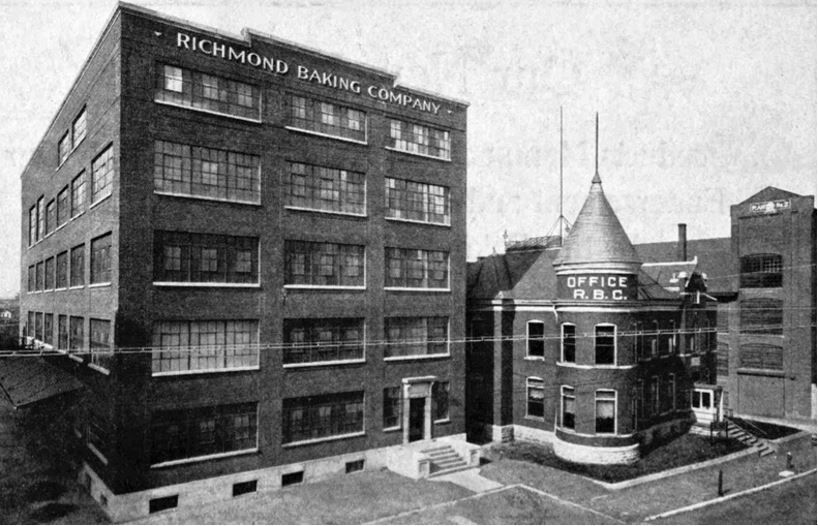
Fig. 1-13 – The Richmond Baking company located near the RR tracks in old Town Richmond on North 6th St.
Ernest death
Ernest died at the Richmond State Hospital in 1948 at the age of 71 due to a stroke. His other health condition was reported as “psychosis”, that could have been caused by untreated secondary syphilis and the reason he was placed in the Richmond State Hospital. Attached are the death certificates of Grace, Ernest, and Walter Elstro.
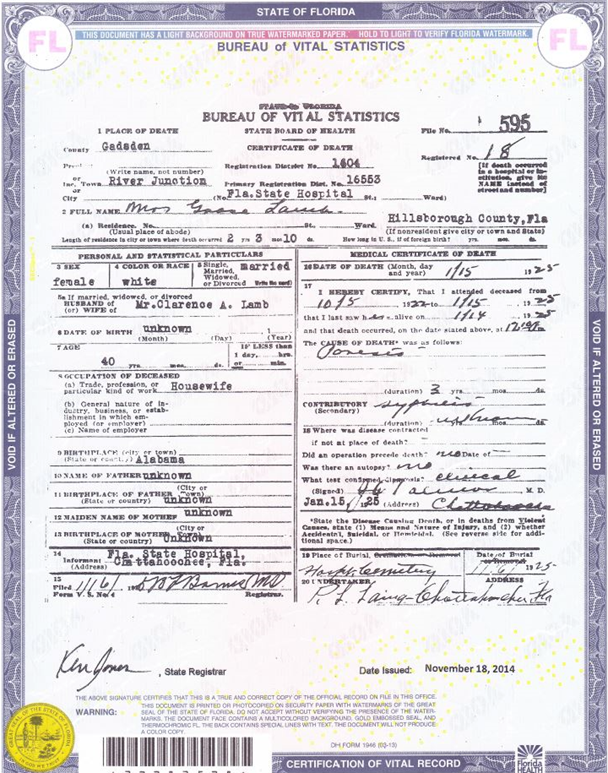
Fig. 1-14 – Grace Wasson Death Certificate
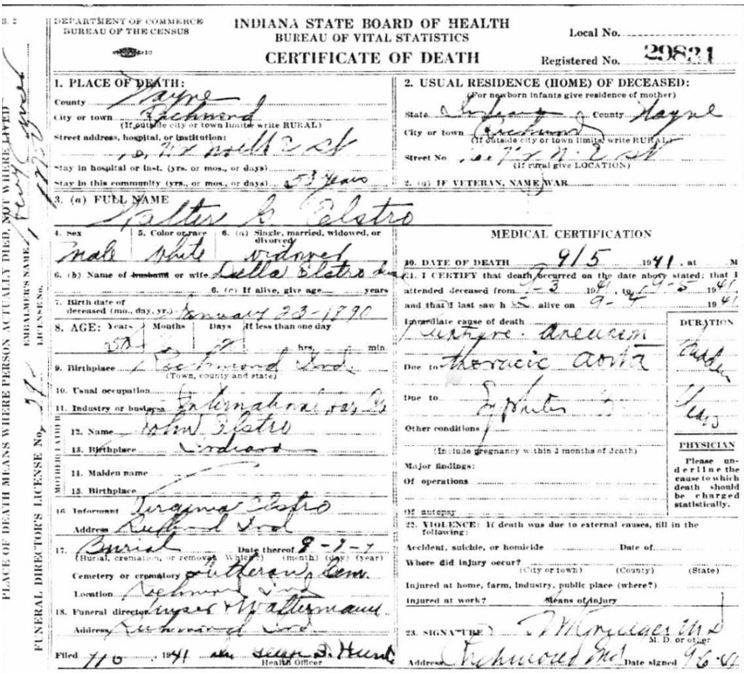
Fig. 1-15 – Walter Elstro Death Certificate – Grace and Walter eloped in 1910 for 4 days.
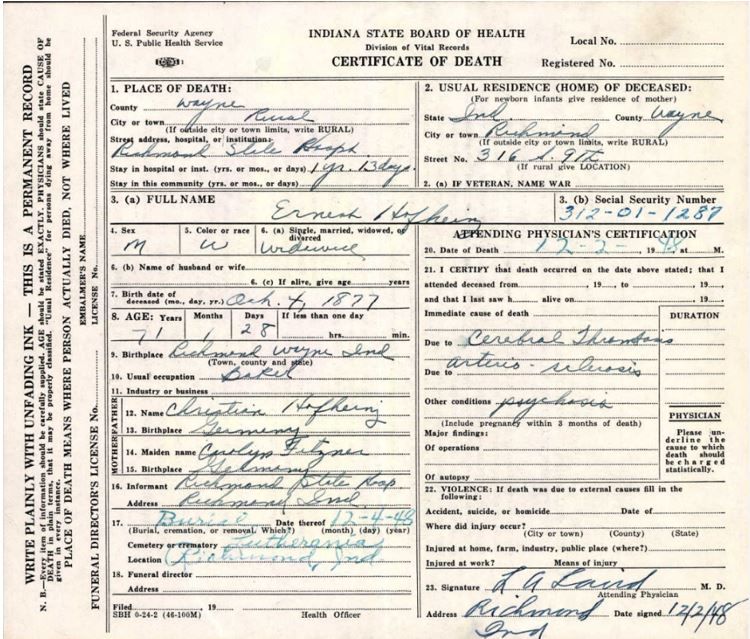
Fig. 1-16 – Ernest Hofheinz Death Certificate
Edith Hofheinz (b1907)
Edith Hofheinz is the 3rdchild of Grace Wasson and Ernest Hofheinz. They lived in Richmond, Indiana. Ernest was a simple laborer working at many different factories and business during his life. Edith was raised and baptized in the Lutheran Christian faith and attended Saint John’s Lutheran Church in Richmond, Indiana. She lived with her aunts and uncle at 316 South 9th Street in Richmond, Indiana. Her mother, Grace Wasson Hofheinz, lost custody of the children when Edith was only 3 years old, and she was raised primarily by her two aunts who were never married, Clara, and Edna Hofheinz. Edith probably barely saw her mother and most certainly was never raised by her. Her father was ever present and lived with them but what parenting he did was little known.
Edith graduates
Edith was the first generation of Hofheinz to graduate from High School completing school through 18 years of age. After high school, Edith lived with her aunts, uncle and father and worked in a garment factory as a packer. At the age of 23 in 1931 she married Walter Erk whose family was also a member of St. John’s Lutheran Church and a year later had their first child, Elinor Erk, my mother, in October 1932. Edith and Walter had two other daughters in the next ten years, Martha, and Thelma.
Indiana farms
Walter Erk, in his childhood, lived on a farm with his family. His grandparents, Harmon and Mary Erk, immigrated from Germany to Richmond in 1866. Harmon’s father, Heinrich Erk (b1814) immigrated at age 56 with Harmon and is also buried in the Lutherania Cemetery. The Scandinavian DNA I have comes this line of family as his ancestors are from northern Germany near Hamburg. When Walter and Edith got married, they lived and farmed on rented property until they bought an 80-acre farm 1 mile north of Whitewater, Indiana. This farm was three miles north of Walter’s father farm on State Road 227. The family continue to grow while Walter worked on his farm milking cows, growing hay and farming fields. This is the same farm I grew up on many years later.
Walter and Edith’s oldest child was Elinor. Elinor would tell me stories about my grandparents. She recalled one evening Walter was walking up from the milk-house after milking cows and lightning stuck a pole next to him where he fell. He was unable to move for several minutes and then he crawled to the house. Walter and Edith made a living on the farm and for extra money Walter drove the school bus for the Whitewater school.
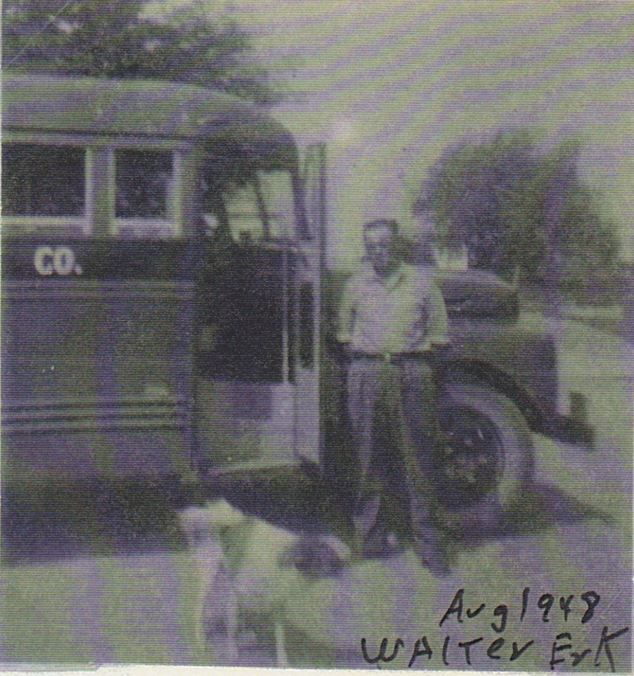
Fig. 1-17 – Walter Erk beside the school bus he drove and his farmhouse in background
Edith's death
Edith died on November 25th, 1949, when she was 42 years old. She was sick for several months and bedridden for the last two. The death certificate states she died of “Uremia” or kidney failure from the raised level of waste compounds that are normally eliminated by the kidneys. This is caused by chronic nephritis. Kidney inflammation is most often caused by autoimmune diseases that affect major organs. Edith oldest child Elinor was a senior in high school when her mother died. Her youngest daughter Thelma was only 6 years old.
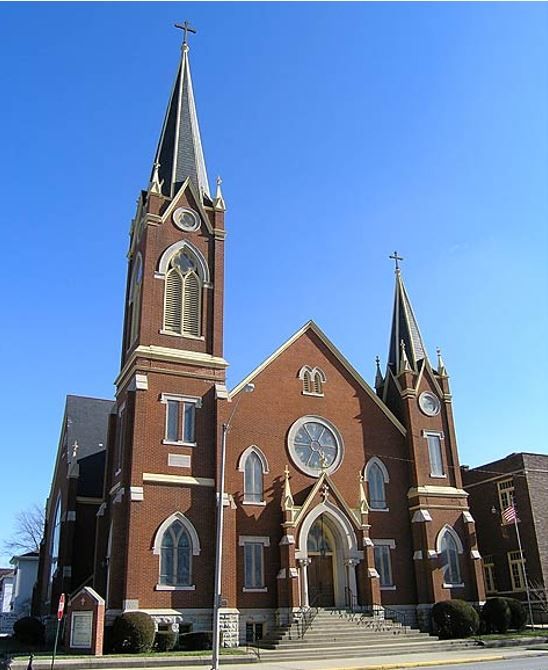
Fig 1-18 – St. John’s Lutheran Church at 501 South 7th St. Richmond, Indiana where the Hofheinz and Erks attended.
Elinor marries John
After Edith’s death, Walter still farmed, and Elinor took over her mother’s housework for the family and cared for her sisters. Walter died of a heart attack 5 years later. When Walter passed away Thelma was only 11 years old, and her sister Martha was 18. Elinor, age 21, was dating John Pearson and they decided to get married soon after her father’s death and Martha got married a year later to Glen Byron Frame. Thelma, still being a minor, was taken care of by her older sister Elinor and her husband John until she got married to Vernon Day. John and Elinor bought the farm from the Erks and were farmers for several years until he started his own Plumbing & Electric business.
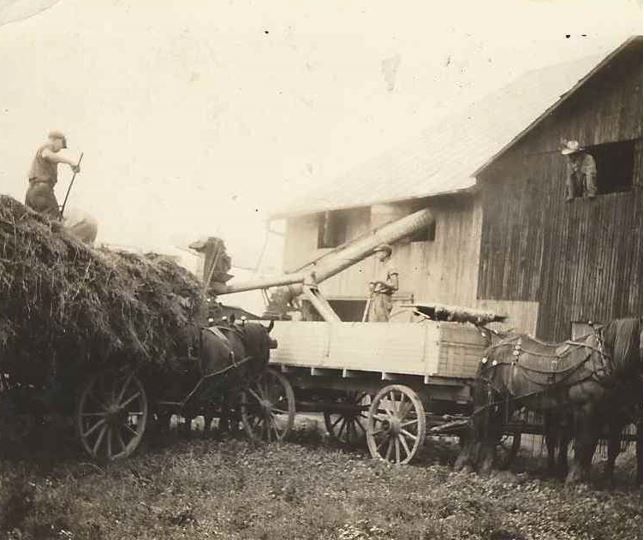
Fig. 1-19 – Walter and Edith’s barn hauling hay with the horse wagons at farm 1 mile north of Whitewater, Indiana
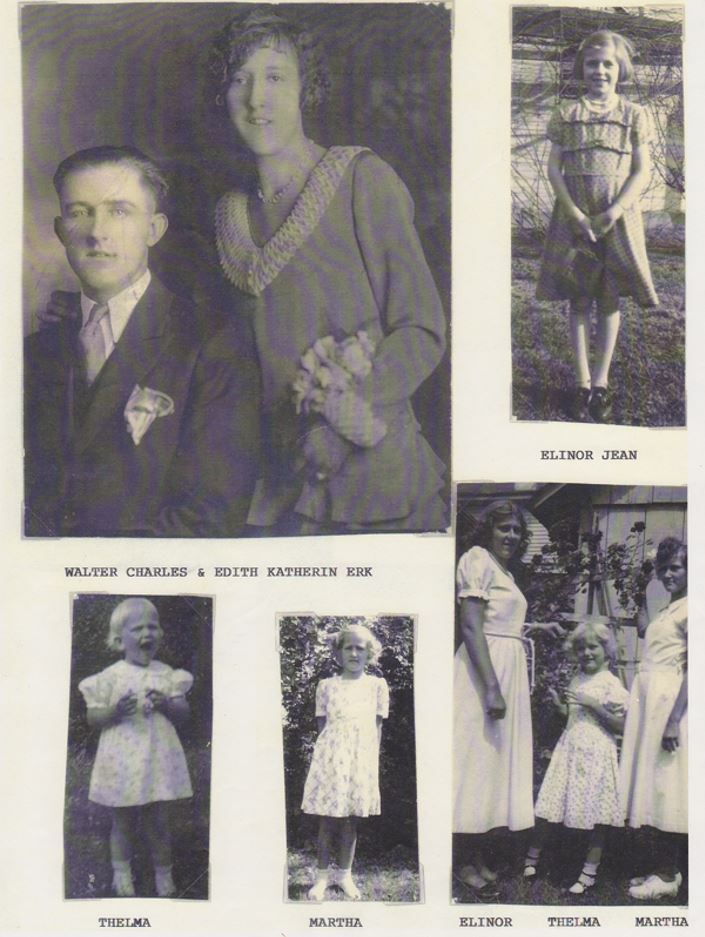
Fig. 1-20 – Walter and Edith Erk wedding picture and their children at different ages
Elinor Erk was the oldest child of Walter and Edith Erk. She married John Pearson in 1954 soon after he got out of the Navy. Elinor lived on the same farm as her father from 9 years of age until her death at 86 in 2019. Elinor used to tell me stories of her high school at Whitewater and her dreams of living in Texas with the cowboys. Much of these dreams coming from books that she read that romanticized the wild west. Three weeks after her father Walter died, John and Elinor where married and John moved onto the farm. They had their first child 1 year later, Danny, and then over the next 7 years had 3 more boys, Terry, Jerry, and Tom. Elinor and John lived on that farm the rest of their lives.
Stories written by Elinor Jean Pearson
Written October 14, 1949, in 12 Grade at Whitewater School by Elinor
I am now a student in the twelve grade, not a very bright but average, not very popular but still I like everyone. There are 16 in my class, all cheerful people when we want to be. We have had lots of fun in all our grades, we would always work together and talk until everyone agrees with each other.
There are a few boys who I personally like, James Smith and Gene Chenoweth and others however not a date with either one. I had a date with a boy from New Madison, Ohio, John Pearson, or Black however I am not sure of his last name. I like his friend, Willard Hart. He has been out of school for one year and must be 19. He never has come to ask me for a date although he said he would.
The Play our school is doing is coming along fine and dandy. Everybody is being nice and there is none of the boy’s foolishness like there was last year in 11th grade. If we have a hayride this year, I hope it will be just the kind that will have fun. Fun is what every senior ought to have. I want more dates, one every month. It is October, and I haven’t had one yet this month. The one I had with John Pearson was nice. It was on September 11, 1949. He is a nice boy and likes farming just like I do. But a girl friend of mine, Evelyne Neal, likes him very much. I do too, but I can’t because she likes him and wants to go steady with him. I like for boys and girls to get a chance to go and try others. I think John feels the same way, but he can’t break her heart. I broke them up once, however they want to go together, so I will let them. Maybe I will get another date if God lets another one come my way. I doubt it after what I did to John and Evelyne.
My mother is sick this year and it is hard to meet ends. I want to work in town, but Dad and Mom need me at home. Besides, my age not old enough as I am only 17, with two other sisters going to school and I should help with them. I hope and pray I can take my class trip. This will be the first trip of my life very far away. I hope Mom will get well. I pray every night.
I want my senior year to end up this way; Dates one or two every month, a good time, lots of fun, Mom getting stronger every month, I can take my class trip, have dates, and be an A and B student at the end of year, however one time I got a C. I don’t expect to be a big, honored student. I bet Gene Chenoweth and Vivian Foster will be. I thank God I have such a nice friend with Vivian. A friend in time of trouble saves many heart breaks of mine.
Motto, I wrote in the 9th grade. My heart was sad then because none of the girls liked me.
- Never forget your prayers or you won’t succeed in anything you do.
I want to be a singer and teach Sunday school class, travel and live in Texas and tell others about God.
Elinor's family - written by Elinor Pearson in 1995
Walter Erk married Edith Hofheinz on January 15, 1931. They were married by Oscar J. F. Tressel, Minister of the St. John’s Lutheran Church. After they were married, they rented a farm near Lynn, Indiana. Claude Moody was the owner of the farm.
I was born on October 31, 1932, at home. My Great Aunts, Clara and Edna would take pictures of me when I was two years old. One was taken when I was in the tub outside at home. I was around 3 years old when my sister Martha was born on November 13th, 1935. We soon moved from Lynn, Indiana to Park Elwood road. There were only three houses on the road; Henry and Ethel Sieweke that lived across the road from us, Lester Isaac who lived on the curve on the northside, and us who lived on the west side. We rented the farm from Earl Freeman. I liked the place. The porch went around the front and east side of the house. There were four rooms upstairs with two attics, a middle room, a bedroom, and a large bedroom where we slept. Downstairs there was a living room, and another living room where we weren’t allowed unless company came. In the back of the house was a closed in porch, a windmill, and a pump where we got our water. We had no bathroom or lights that I can remember. One time I asked my mother if I could see the smoke house and the underground cellar. My mother took me and there was hog inside getting cured. I don’t remember if I ever went down in the cellar. There was also a garage next to the house.
I started to school when I was five years old sometime before November. I remember riding the school bus. They had second grade together with the first grade and I was scared. Our teacher’s name was Mrs. Peau. My sister met me when I got home, and my mother took a picture of us.
Isaac, our neighbor, made toys for us and wooden blocks so we could build anything with them. In the summer, Henry Sieweke, would have a thrashing rig come out and he would thrash wheat or oats for us. I would watch them and after they were done, I ran into the straw pile and got covered with straw and itch all day.
Our farm
In 1941 my father bought a farm of 81 acres. I was eight years old when we moved to the farm on road 227. It is one mile north of Whitewater on the east side and ½ mile north of the Whitewater school. I wish the school was on the west side. The farmland also had a woods and two thickets. One on the north side and on the south side of the field. A small stream went through the farm, and we called it the Whitewater river branch. Our neighbor was Fitzwater, and his girl went to my school. They lived behind us. Part of his farm was in Indiana and the other part was in Ohio. They lived there for years then they moved to Glen Karn, Ohio just north of Hollansburg. They had a grocery store, elevator, and chicken factory where chickens were killed and sold. I worked there when I got out of school.
My dad had 5 cows we put them in their stalls to milk them and I learned how to milk. There was a cow named Betsy that I would milk if I didn’t get her done on time, she would just lay down. I milked by hand since we had no milker. We would put our cows in the milking parlor and tie them in their stable. They seem to know where to go. After we were done milking, we would put the milk in a can then put the can in cold water to keep. The next day the milk man would come and pick it up. My sister and I would pump water into the water trough for our cows, and the tanks that we kept our milk in.
I can remember at first, we had two horses that we used to farm with. Then my dad bought a Ferguson tractor you had to crank to farm with then he got a John Deer tractor that you had to crank it was green tractor. Then he got a Minneapolis Moline a tractor you didn’t have to crank it was yellow tractor.
Our barn was an old barn built by John White the grandfather of Ralph White the neighbor we knew for years and is still living up the road north of us first farm on the west side, his parents’ house. His Grandfather also built the house we lived in. Ralph’s field is next to our lane, and our farm is just north of it. He must be in his late 70 or early 80s. The barn had a corn crib and a large place where we would put our tractor in and a large place to put our hay up in the hay loft. We made hay for a few years with a hay loader that you pick up hay and load on the wagon. Then would take the hey to the barn and put into the hay mow.
We had a wheat machine that would cut the wheat and then bale it a machine that would tie them and I would dump them, then we would stack them until we were ready to thrash, then we would take them to the threshing machine to take out the wheat and throw the straw into a pile. The thrashing machine would go around from farm to farm to thrash wheat there would be a lot of men that would help the thrashing some had horses or tractors
There was also a corn sheared. We would cut down the corn then tied it into bundles then pick them up tie them together, then bring them to the barn and it would take out the corn and sheared the corn stalk put in a pile outside like we did for the cows where they laid.
I would go after the cows every day and I would enjoy it. It was a long ways back to get them, sometimes they would walk up to the end of the woods and stand and wait for me, they very seldom would come up themselves unless it got to late or rained.
In the late forties things changed not any horses, however now tractors, and one row corn pickers, small combines to combine the wheat in the fields, and later balers to tie our hay with binder twine and wire bailers. My cousins and my dad and I would help my Uncle bail hay.
When I was around 13 years old, we would play in the barn when the hay got down, we had friends that lived 2 houses south of us that would come up and play with us, Bonnie and Peninnah Hardwick and my sisters Martha and Thelma would listen to Bonnie, and I put on a show. We made our own garters and used them to sing. We enjoyed many songs and some we made up. Sometimes we would playhouse a rubber doll we liked.
On Saturday night we would take a bath we would use a round tub we called our bathtub. We would fill it with water, and each would take a bath in it. I can remember on Saturday nights after we took our baths, we went to bed upstairs we listen to the radio it would do shows like the Roy Rogers show and the Cincinnati Ohio singing and square dancing. They had a lot of shows I would listen to even when I washed dishes I would hurry and get them done so I could listen to them. We used the radio on a long table in the living room it had 2 batteries to make it run. We used Kerosene lamps in the living room and dining room and on the wall in the bedrooms.
When my mother washed, we used a washing machine we would rock back and forth to clean the clothes, we would heat the water in a boiler on a kerosene stove then pour it into the washing machine. My mother and dad would can peaches and meat in cans that were blue with zinc top lids. Put water in the canner put in 7 quart of 10pints of beans would take 1 or 2 hours to can them, the meat would take around 2 hours to can them. My mother would show me how to cook and make a pie, but I liked to work in the fields.
We got our electric in 1942 and my mother bought a new electric lamp which I still use today. Then we would use an electric washing machine and electric stove. My sister Martha had celiac disease she had to eat different things I remember she had to eat around 40 pounds of bananas a week, there was a store on 5thstreet in Richmond we bought them my Mother would take eggs in to buy them, she had to be on the diet until 13 years old her legs were always swelling
Our House
Our house had no electric or bathroom when we moved in. My parents’ bedroom was long and small. The kitchen was small, and the other room was our dining room. The house had tall windows in the living room. Our bedroom was upstairs. It also had two attics, one on the south side and a little larger one on the north side.
When I was in the 3rd grade our neighbor north of us was coming home from work and seen our house on fire and stop and told my father that was milking at the time in the milk-house. My dad ran upstairs after Martha and me and we made it down before the walls fell in. The man called the Holansburg fire department, and they put it out. The fire just burnt the upstairs. We then slept in the dining room. After that my sister and I got the measles and we had to stay in bed in the dining room while the man was fixing the upstairs.
In the 4thgrade a new girl started school. Her name was Vivian V. Foster. She lived south of Whitewater just before Inke Road. She became my girlfriend. We have been friends for years. She moved away after graduation however I stayed. After Vivian went to college to be a nurse she got married and moved out of this area. I stayed here and seen everything that comes and goes however I wouldn’t give it up. I also married a man that I love very much and wouldn’t change place with anyone else.
My sister was born on April 21, 1943, at home. We came home, Dad met us and told us her name was Thelma Edna Erk and she was born today. We had around 2 inches of snow that day, and I was in the 6th grade. I am eleven years older than she is. In 1944, we got our first electric in the house, and we were so happy. My mother got an electric lamp that I still use today.
In 1945 I had rheumatic fever. My legs hurt and I had a high fever. My dad asked me about it after he found out that our neighbor girl had it. The next day, I went to the doctor he said I had it also that I would have to stay in bed I did for 3 weeks. The doctor would come to the house and see me and gave me medicine that helped. When I went back to school my gym teacher wouldn’t let me play cause my legs would hurt. In the summer I had my tonsils taken out. I got better but my legs bother me when it would rain for a few years after. After that everything was just fine, I had no more trouble.
My mother died the day after Thanksgiving on November 25, 1949, at age 42. She had high blood pressure and Bright’s disease. She was sick for 2 years. During that time, I had to come home from school and be with her when my dad would help his brother farm.
There was 15 of us that graduated high school in 1950 from Whitewater school. We had a nice graduation. Some went to college, and some got married, others waited a while. After I graduated from school our class took a trip out east on a gray hound bus. We went to Washington D.C., Maryland, New York, Niagara Falls and then back home through Michigan. I liked the Trip. After the trip, I stayed home and worked at home and away.
After I graduated high-school, I would take care of my sisters Martha and Thelma. Martha was in the 9th grade and Thelma was not in school yet. I would make clothes for her when school started, on an old Singer sewing machine, I helped in the field after my mother died. My dad and I would chuck corn to open the field. We would do about three rows before we could use a corn picker. I got a job in Richmond at the Bartle’s overall factory. I would put rivets on it and the pockets about 3 or 4 months then got laid off. After that I got a job at the school helping clean the grade classes. Then I got a job in Glen Karn, Ohio at a chicken factory. We had around 30 people working there. My girlfriend Evelyne Neal worked on a machine taking feathers off the back I would take feathers off the wings of the chicken. I started at 60 cents an hour. I remember our boss talked to us and told us that we would make 75 cents an hour however I made 80 cents an hour because I was there longer than what some were. I worked there 2 years then got laid off as they closed the place the last half of 1953.
My Husband
One day, when John was in the service, my girlfriend gave me his address so I could write him. Vivian had found someone else to love and his name was Vernon. I wrote to John, and he wrote to me. My father died on May 2, 1954, and John and I got married May 23, 1954. After his death my sisters lived with John and me. We raised them until there were out of school. Martha got married a few months after we were married. Thelma was 10 years old and lived with us until she got out of school and then got married. Her friend was Peninnah Hardwick. She lived down the road 2 house south of us, they were always together, they would ride their bikes to Peninnah house and lose some of their clothes at the end of the lane and we always laugh about it. When the boys got a little older, we would go to the woods to pick berries and take them in their wagon. After they got older, they wouldn’t want to go down to the woods, so they stayed at the house.
Our family
John and I have four boys. Danny Ray, Terry Lee, were the older, then four years later Jerry Neal and two years later Thomas Edwin. They all went from the first grade to the 6th grade here at Whitewater school and the 7thgrade to the 12th grade and graduated from the new school on Wallace road called Northeaster High school 7th to 12thgrade. My boys all graduated from there. My sister Thelma Edna married Vernon Day. They had 2 girls Leona Sue, Pamala Louise. They graduated from Richmond Indiana. They are both married and have two children Leona 2 boys and Pamala has 2 girls.
In the summer they would have the baseball games and would like to be in them. They had them up here at whitewater school until they got older and went to northeastern then had them in Fountain City at the ball field.
After Danny and Terry got 12 years old, they started milking every morning and evening. They got paid for it they asked to do it. When they were little boys, I would milk every evening Thelma would help me. We would leave the boys in the playpen up here at the house. John would work at night so I would milk at night he would milk in the morning when he came home from work. Danny and Terry milked until they were out of school, then they asked Jerry and Tom if they wanted to milk, they said no so the cows were sold but the boys would help their neighbors make hay when they called them.
There was a time our lady Mrs. Smith on Hill Road seen our boy Jerry in our mailbox. I don’t remember how old he was. We have laughed about that. It is a large mailbox. I see her occasionally and she recalls it and we both laugh.
Tom was a ball player and would play basketball and baseball until he graduated from high school. He got to play one summer in Richmond on the baseball team. At the baseball park some other ones did to from his team at high school. At one ball game in Richmond, he got some tobacco that he chewed before he went back out to the field, he fell over the trash can he used and almost knocked it down. We laughed about it.
Chapter 2
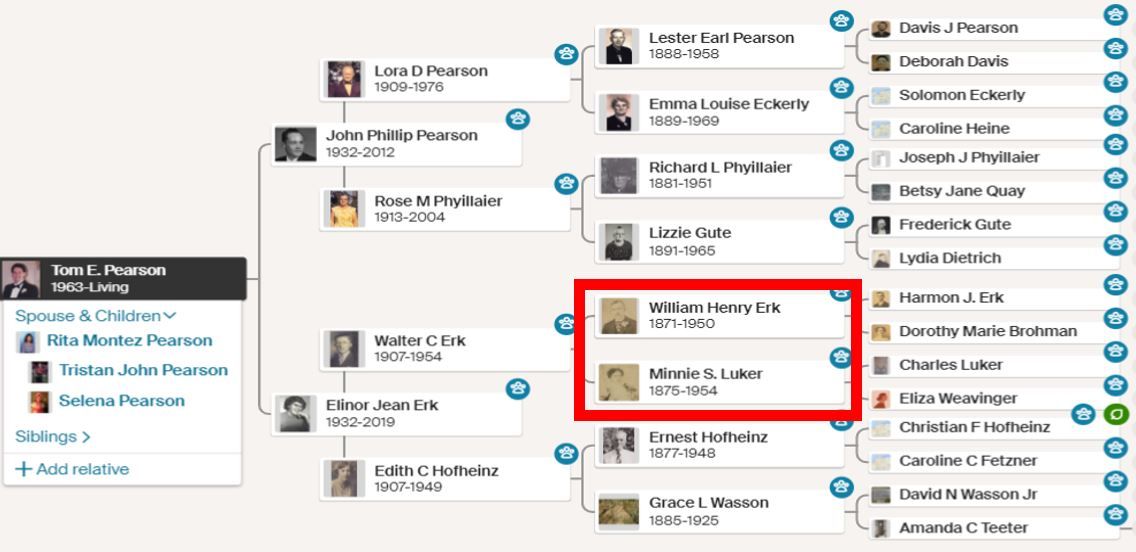
William Erk (b1871) and Minnie Luker (b1875)
Fig. 2-1 - Tom Pearson’s family tree with red box around Great Grandparents William and Minnie Erk.
From factory worker to farmer
William Erk and his wife Minnie owned a farm 2 miles south of Whitewater, Indiana. Before William became a farmer, he worked in Richmond. His longest job was at Starr Piano factory where he worked as a gluer and toolmaker making enough money to buy a farm when he was about 43 years old. It was a dream in those days to own your own farm and be a farmer.
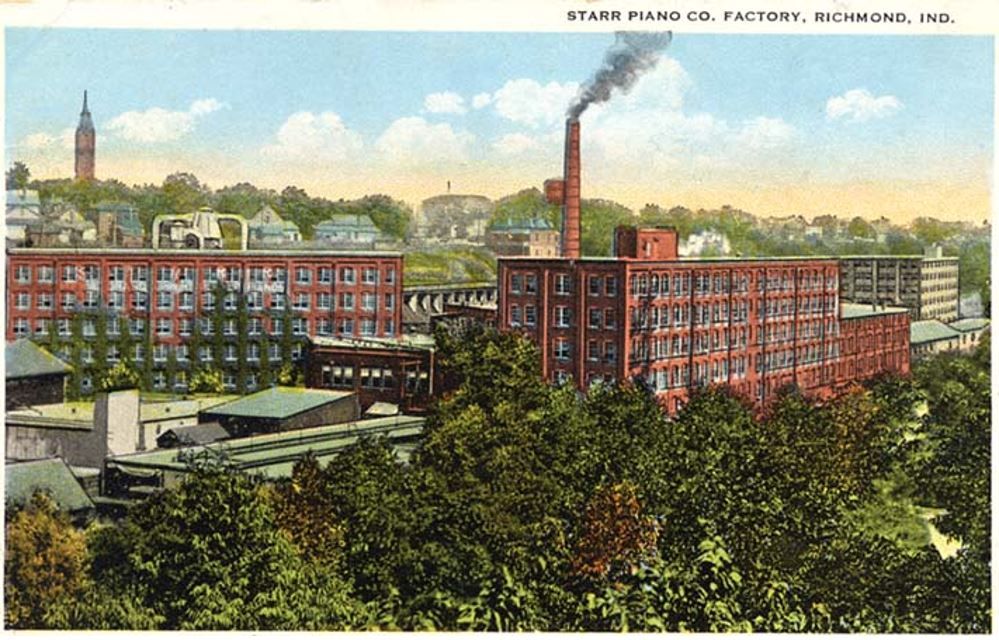
Fig. 2-2 – Starr piano factory in the Whitewater Valley gorge was largest employer in the early 1900s.
Williams Erk’s parents, Harmon and Mary Erk were Lutheran immigrants from Germany and settled in Richmond, Indiana in 1866. They lived at 500 South 13th street just blocks from the Saint John’s Lutheran church where they were members.
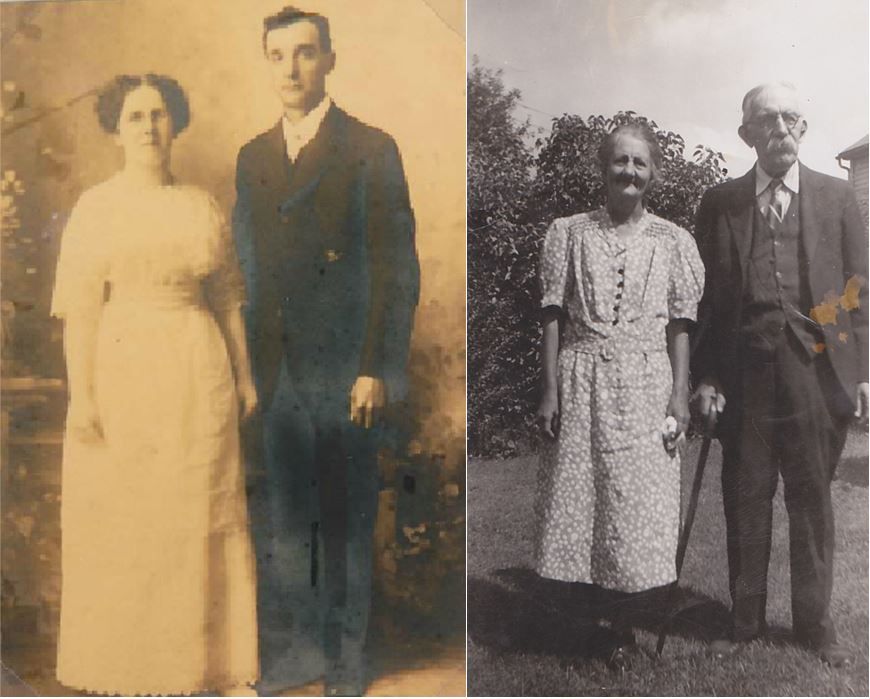
Fig. 2-3 - Picture to the left is my 2nd great-grand parents, Harmon and Mary Erk, Richmond immigrants from Germany. To the right my great-grandparents William and Minnie Erk.
William Erk and Minnie Luker were married before the turn of the century on February 10th, 1898. They had their first child two years later. Minnie Luker’s father was also a German immigrant and her mother’s grandparents were from Germany too. Minnie’s mother died when she was 3 years old and was adopted and raised by her grandparents until she was married at 22. William and Minniefarm before they bought it was an inn for stagecoaches passing through the area. It was built in 1806 and was located 2 miles south of Whitewater Indiana. William died in 1950 at age 79 and Minnie 4 years later at 78. Their child Walter Erk life was described in Chapter 1. Below is the house William and Minnie lived in and pictures of their family. The color pictures are from a my visit in 2015 by Thelma and Elinor after it was restored.
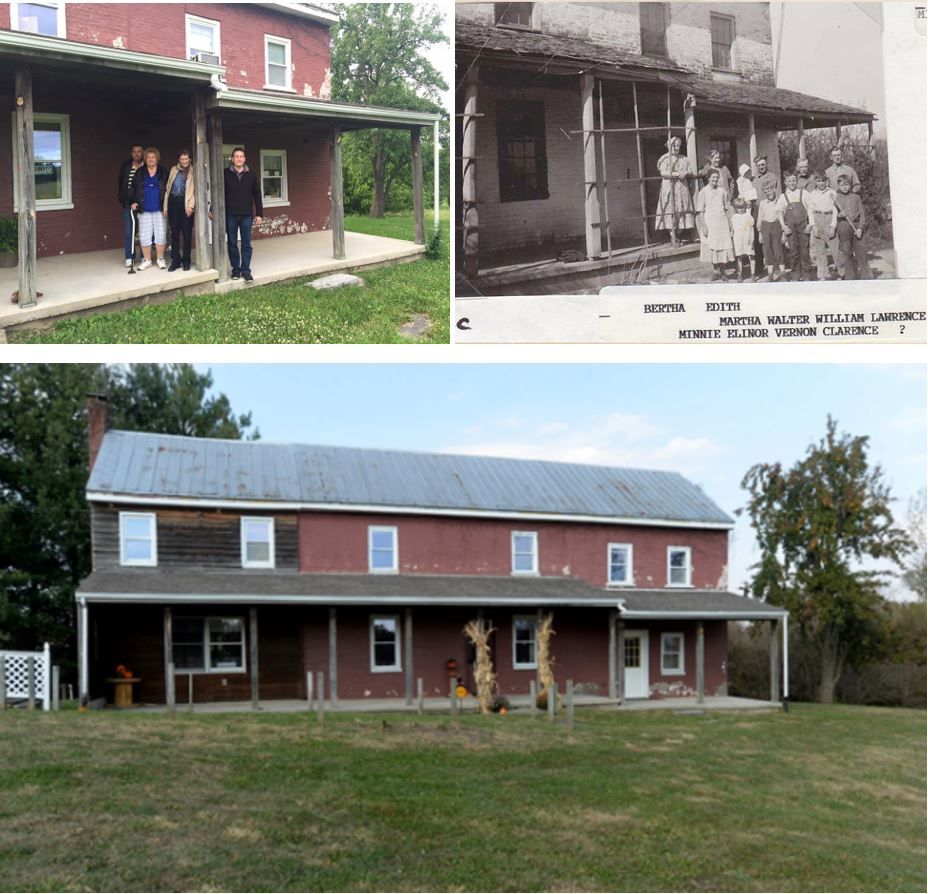
Fig. 2-4 -Farmhouse of Great Grandparents William and Minnie Erk in 2015 with and 1940.

Figure 2.5 – Richmond newspaper reported sale of farm to John and Elinor
Lawrence Erk (Elinor's Uncle) and administrator of the late Walter Erk’s farm sold the 80 acre farm for $12,000 ($122,000 in 2022). Lawrence Erk held this money in trust until Martha and Thelma was of age and then gave it to them. The story of Elinor Jean Erk life and her family is told in Chapter 1.
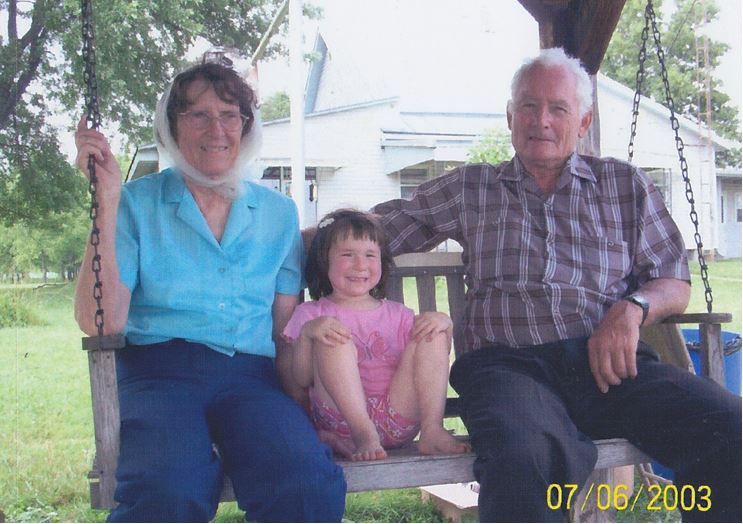
Fig. 2-5 -Farmhouse of Elinor and John Pearson – Elinor, Selena, and John on swing
Chapter 3
Richard Phyillaier (b1881) and Lizzie Gute (b1891)
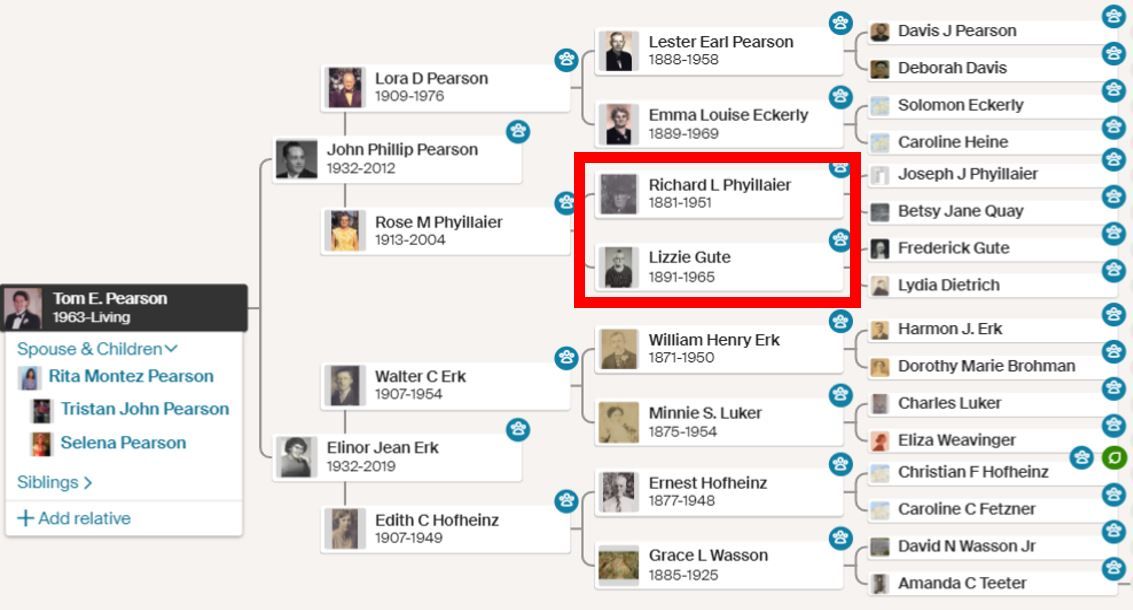
Fig. 3-1 Tom Pearson’s family tree with red box around Great Grandparents
Richard and Lizzie Phyillaier
Richard and Lizzie were both from Owosso, Michigan and grew up on family farms in the area. Richard Phyillaiers’ great grandfather had immigrated from Rhine River in Germany around 1790 to New York. Then the Phyillaiers migrated westward from New York to Michigan when the United States opened the area for first time settlers in the 1840s and 1850s. Treaties were signed with native Americans moving their territories west of the Mississippi opening Michigan, Illinois, and Indiana to European settlers. Lizzie’s grandparents are from Germany and followed the same migration path to Owasso.
Eloped in Canada
Richard and Lizzie Phyillaier grew up on their parents’ farms near Owosso, Michigan. Richard was 27 when he eloped in Canada with his bride Lizzie who was 17. Why did they decided to get married 120 miles east of their farms and just over the Canadian border near Sarnia, Ontario? It is likely they took the Grand Trunk Railway that had passenger stops in both places. It is also likely the same path their grandparents took when they emigrated from Germany. After their marriage, they set up housekeeping on a farm just east of Owosso. There they raised six children including my grandmother Rose Phyillaier until one day when everything changed.
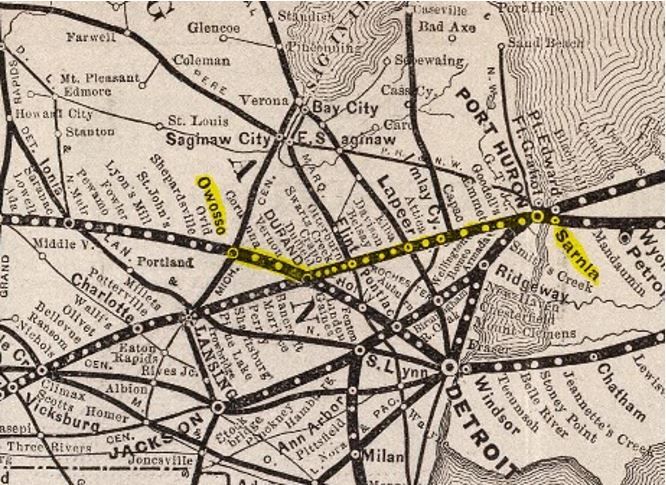
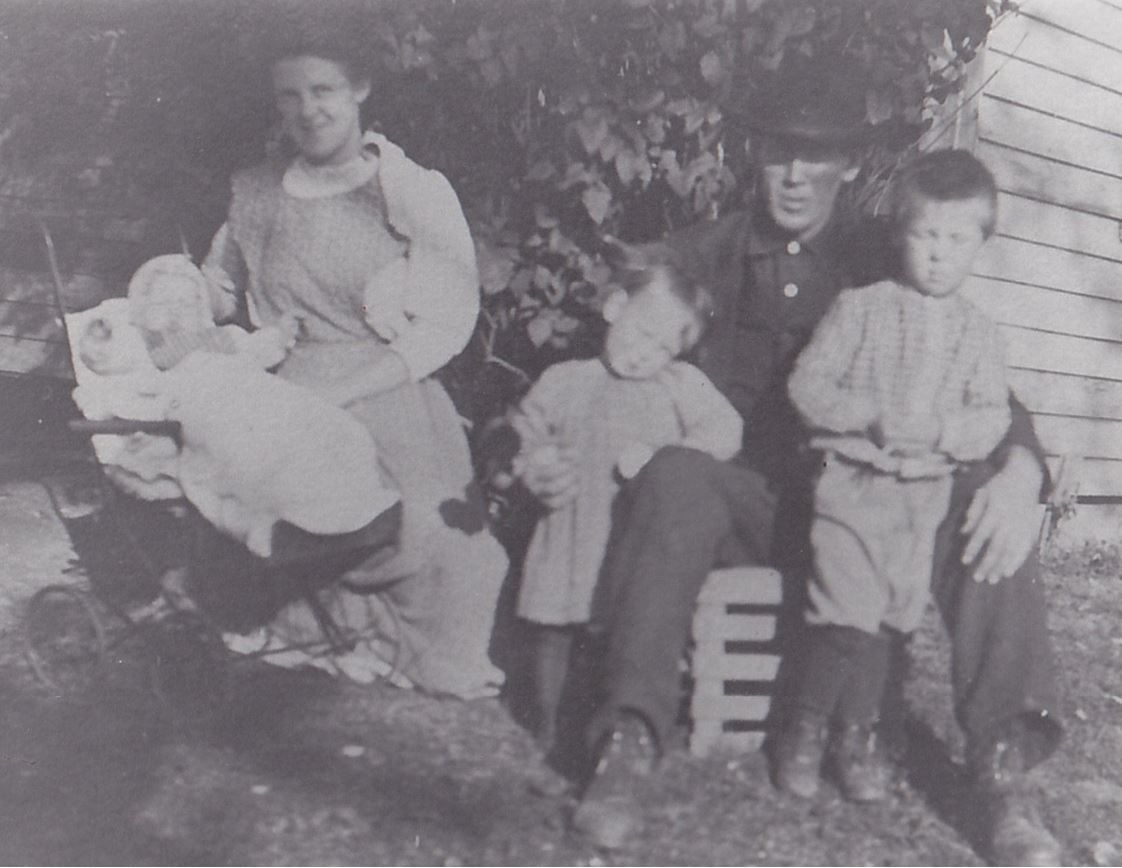
Fig. 3-2 – Lizzie and Richard Lewis Phyillaier and children oldest to youngest Elvin, Arthur, and Rose
Dad goes to prison
Rose, my grandmother, who was only seven at the time tells the story that shook the community.
Dad gets his gun and takes it to the neighbor’s barn. Dad and the neighbor Shepherd started talking and Shepherd hit dad over the head with a pipe and busted his head open. After the altercation they took Shepherd to the house and put him on the kitchen table, I guessed he died soon after.
The story is best told by newspaper articles that put on the front page the argument and the murder of Merle Shepherd. The article in the Owosso Times reports that a snowball fight between Shepherd’s children and Phyillaiers children was the catalyst for the murder. When Richard Phyillaier confronted Shepherd about it, a fight occurred, and Richard shot his gun 6 times fatally striking Shepherd. Richard claimed self-defense however was arrested and sent to life in prison. The incident sorely changed the direction of both families.
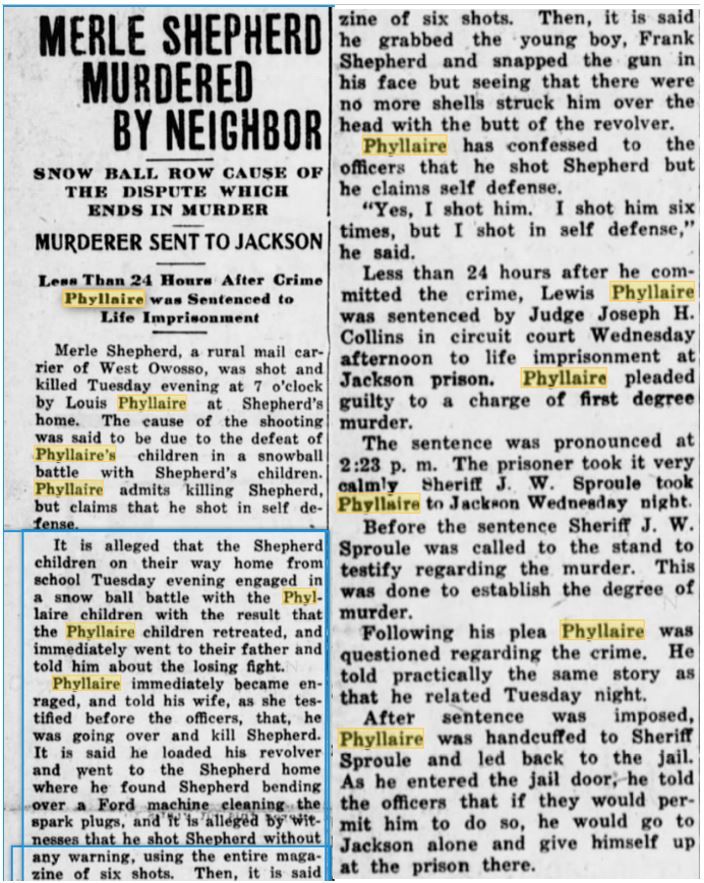
Fig. 3-3 – Phyillaier murders neighbor – Nov. 18, 1921, Owosso Times
Another newspaper article in the Lansing State Journal details the tragedy of the affair.
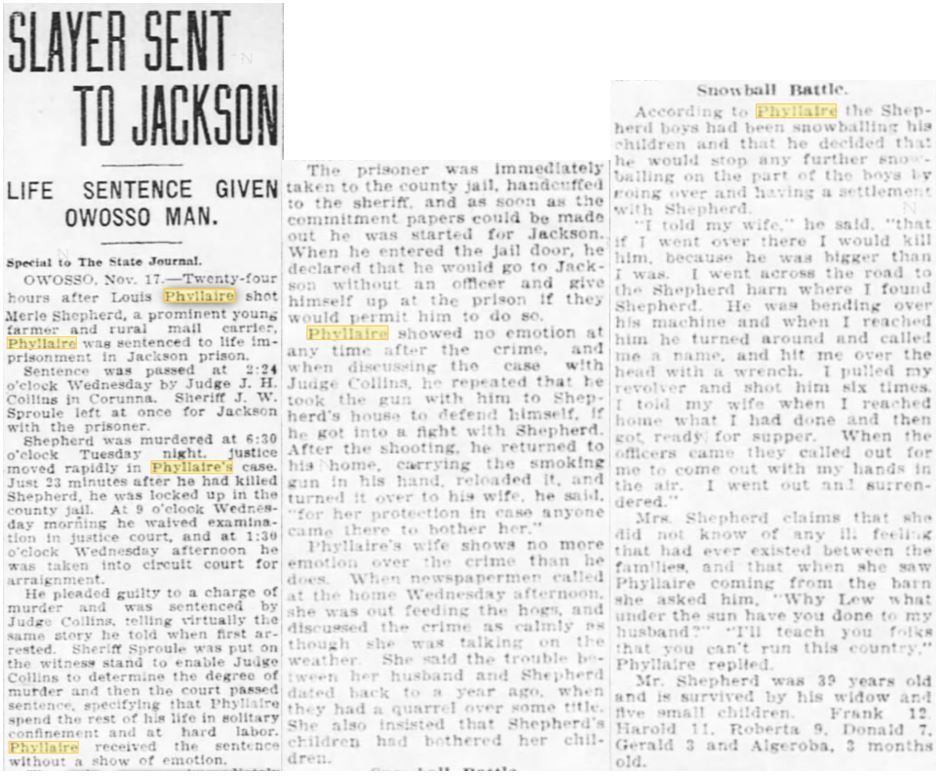
Fig. 3-4 - Slayer sent to Jackson – November 17, 1921, Lansing State journal
Rose Phyillaier Pearson told us that they fell on hard times after her father was sentence to prison. Lizzie soon needed to remarry, and the newspapers reported on her problems doing this also.
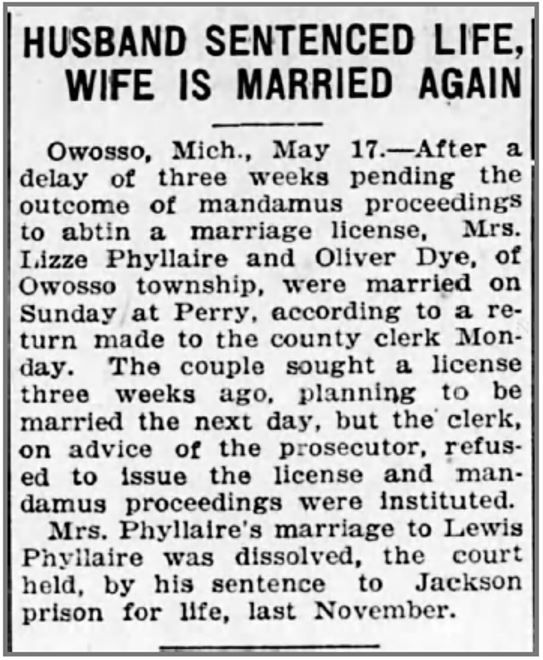
Figure 3-5 – Lizzie Phyillaier marries Oliver Dye
Seven months after marriage, Lizzie and Oliver had their first child Leonard Dye. They had a second child two years later and then a year later they divorced in 1924. Lizzie found herself broke, with no income living hand to mouth in a rental “shack” next to railroad tracks with several children in tow. Rosetold us that Lizzie had to make money anyway she could and that she remembered men were coming in and out of the house during the evening and night. It had been hard times for Lizziesince Richard went to prison, so one day she decided to take her family and move to Tipp City, Ohio. The Owosso town had denigrated her as the wife of a murderous husband and her farm was taken away from her by a second marriage and divorce to Oliver Dye. Nothing was left for her in that town, so she scraped together enough money to buy a car and left Owosso behind. Lizzie and her older children worked as farm laborers until 1940 when she married William Mote. Her children went to school in Milton, Ohio.
Dad released from Prison
Thirty years later Richard Lewis Phyillaier was released from prison. A judge, reviewing the case, realized that Richard never had a trial or a lawyer to help negotiate a life sentence in prison. There was circumstance that were never considered such as the wound on his head, self-defense or even 2nd degree murder which would carry less of a sentence. The new judge commuted his sentence to time served and after 30 years Richard Phyillaier was release into the custody of his sons. Living in prison can institutionalize a person. The outside world can be scary and confusing. His daughter Rose told us he was resentful he didn’t make anything of his life and that the farm was taken away from him after he went to prison. He was release in 1950 and a year later he took his life at age 69 with a shotgun in a shed when his son was away in town. His father, Joseph killed himself in the same way 40 years earlier. Below is the newspaper article that tells of Richard’s father’s suicide.
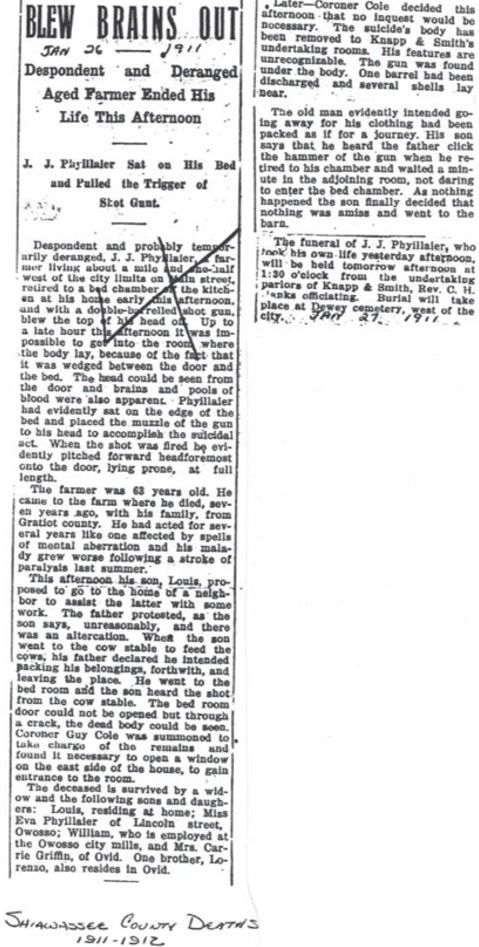
Fig. 3-6 – Richard’s father Joseph killed himself in 1911 – Shiawassee newspaper
After Rose Phyillaier finished school she met Lora Pearson in West Milton, Ohio. They got married in 1931 and had their first son John Pearson 6 months later. Rose and Lora in the next several years had two sons and two daughters, John, Don, Carol, and June. They lived on a farm 3 miles south of New Madison, Ohio. They farmed crops and milked cows and Lora also had a junk yard where he bought old cars, tractors and such and placed in a field just east of their house and sold parts from them. John Pearson lived and farmed there until he went into the Navy in May, directly after he graduated high school at 18 years old.
Rose Phyillaier recalls events in her life
Richard Lewis Phyillaier altercation with neighbor
Dad gets his gun and takes it to the barn. They got to talking and the man hit dad over the head with a pipe or something and busted his head open. Dad must have shot the man. They took the man to the house and put him on the kitchen table he died soon. The sheriff came out and took my dad and he never came back. He said that he didn’t want to spend the money for the lawyers. He left the farm to my mother. He did not take care of his children. So, he left and never came back until 1950.
Dad liked to work, and he didn’t like his sister Glady because he was jealous. He was jealous because all his brother and sisters had their families and their farms however, he never had the chance. He just had to lie there in jail. Elvin and Arthur, his sons were very sorry that they went to get dad out of jail. They thought there were doing him a favor, but he didn’t like it and so when Elvin went to town Richard got the shot gun and went out in the little building and shot himself. He was as in a lot of pain, I know he was because when he left my house, his back was really hurting him. I think he could not stand to live because he was so much in pain. He probably was in so much pain he wanted to die. His Father shot himself also (Joseph Phyillaier). I slept in the same bedroom where the bullet hole was.
I don’t remember my grandparents. (Joseph Phyillaier & Betsy Quay). I kind of remember my Aunt Eva Phyillaier, she was my father’s sister. They moved to North Dakota. I got Christmas letters and birthday cards until 1928 from her. But after we moved from Owosso, Michigan to Ohio, she didn’t have my address and they couldn’t come anymore. My grandparents moved with them to North Dakota then onward to Beaver Lodge, Alberta, Canada.
I remember after my father went to jail my aunt came down from North Dakota to get me. You know it was such a dirty scandal with dad going to jail. We were having such problems with no place to live. They sent the commissioners out to take us to the children’s home. My brother Richard had scarlet fever and Arthur had to stay home with him. Elvin stayed at Aunt Dora’s and Uncle George, so he didn’t go to the children’s home. However, I do remember Paul and I were taken to the children’s home. We only slept there a couple of nights. In the morning, the woman in charge of the home was getting Paul ready to go to school and she tried to take his shirt off and then something happened. You talk about a mad woman. She was really, really mad. She called the commissioner and she told him “You come and get them both and don’t you ever bring them back”. So, we got to go home.
My mother married Oliver Dye because she was pregnant. We moved to Trails farm and there we tried to farm. We raised geese and that is where Leonard and Marcella Dye was born. Back in those days, you stayed in bed for several days after you had a child. I slept in the staircase. I loved this house because it had a living room, parlor room with two bedrooms off the parlor, and a small upstairs. The kitchen was very small.
I was eleven years old and walked to school. Elvin went to school there too when he lived with Aunt Dora and Uncle George. Once, Elvin went and get a Christmas tree for the school. He sat in school all day long after that with cold feet and got the quinsy (tonsillitis). He had a very bad sore throat and ran a high fever. I remember him lying there in the bedroom at Aunt Dora. That’s the first place I ever saw a telephone. The kind of one up hanging on the wall and you ring it.
Michigan Memories
Our house in Michigan after mother got divorced from Oliver Dye was an old building. There was an old shed across the railroad track which somebody came and helped her fix it up so we could live there. It was very close to the railroad. There once was a little girl that rented the house who got killed on the tracks. I didn’t see it however that is what my mother told me. All six kids lived there for years in the shed. Momma worked and us kids where there by ourselves a lot of the times. I was about eleven and Elvin would have been fifteen.
I don’t know how we existed but somehow, we got along. Momma worked enough to buy her a 1928 Chevy sedan. This is the car she brought us to Potsdam, Ohio. Nobody knew we were leaving or when we got there, where we came from. She just ran off. We lived there in Potsdam at first until we moved over to West Milton next to the river. We would help plant tomato plants or tobacco plants. Us kids would help with planting the tobacco. Once, my brother Elvin got a real bad sunburn. I don’t know how he went out there and cultivated, but he got the most horrible sunburn. He just didn’t know he needed to cover up.
Us children we went to school in West Milton, Ohio. I went there when I was fourteen until I got married. I met Lora Pearson in West Milton. Alberta Raymond who lived across the road was running around with Lora and that is how I met him.
First memories of Rose
Some of my first memories. Our driving horse Molly kicked me on the top of my head as I walked behind her as she was standing in the stall. She thought I was a chicken, and she didn't like the scratching behind her. I can still see my dad as he tied Old Molly to a post and whipped her with an old black snake which is a mean type of whip. Poor Molly! We always used Molly, hitched up to the buggy to go to town or wherever. I remember my cousin, Lester Phyillaier coming home from WW1 and stopped by to see us in his Khaki Army uniform. these army boys were called Dough boys. Every summer several gypsies in their house buggy would travel by stopping. One of the ladies would ask to tell your fortune in exchange for food or other things. They sometimes steal by putting stuff in the fold of their big bulky clothes if you weren't looking. I would lie on the floor reading my book by lantern light oil as we called it. (Kerosene) We would dry apples from the sweet old apple tree in the yard handing them above and across the kitchen. The Spanish Flu where so many people died in 1918 struck my mother, two older brothers and the one younger brother that was only six-month-old. They stayed in bed while I I run around all over the house and never got sick at all. My father was sick also but was still able to drive the horse and buggy to town to get medicine and food. These days we had no electric, no bathrooms and we went to the little outhouse with two holes outdoors. In the cold and at night we used the pot and carried it out the next day. We used a Sears Roebuck or Wards Catalog for toilet paper. In those days we didn't even know toilet paper was made. We took our bath either in a big, galvanized wash tub or took a sponge bath and that wasn't very often. We wore long johns and changed once a week. We washed our clothes in a wash board and rinsed by hand. We lived between the road and railroad tracks so every summer I would go out to pick the wild strawberries that grew along the railroad. Wild strawberries have a different taste than tame ones. Mother would bake a plain yellow cake and serve with fresh strawberries and sugar. Sometimes we would can them. Good! Good! We picked huckleberries in the swamp territories and the mosquitoes would bite us all over too. In the winter the family would hitch up the team to the bob sled and drive over the snow to grandparents’ house four or five miles away. We heat up bricks and large grindstones to keep our feet warm and put in bottom of the sled and covered our laps, as our heads would be in the cold open air. We heated our house with a space heater. We kept enough wood chopped to supply all winter. In the kitchen the flat range we cooked all our food and baked in the range oven and heated our water in ware built right side of stone.
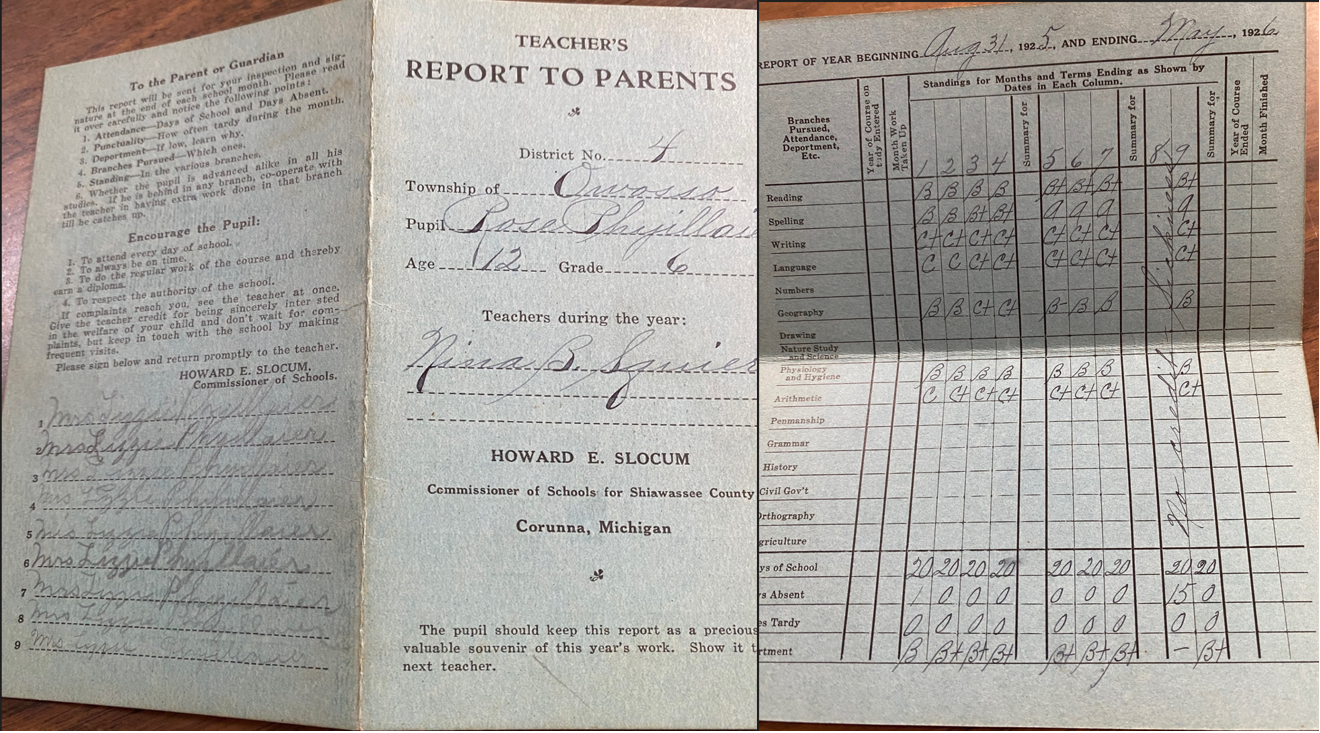
Letter from Rose's Aunt – her mother's sister
Letter was written by Rose's Aunt Agnes Gute Burkhart: Our grandfather Ferdinand Dietrich was born in Berlin, Germany Jan. 30th, 1826. He was educated there, where is not known. He died April 24th, 1900. His father had a large mill and employed lot of help. Grandfather worked in the mill. There weren't elevators as we have today, and the grain had to be carried on their back up 3 or 4 stairs and dumped into bins. In the course of time Grandfather and another brother came to America. Grandfather settled in Owasso, Michigan and his brother settled in Iowa and became very wealthy. However, there were not poor men when they landed in America. They had money to buy up a large tract of land. That was different in that most people coming to America were poor. One wonders if they didn't land in Canada first before coming to Owosso because it is known that Grandfather married a widow with children in Canada. It was there where Uncle Will, the twins Uncle Aaron and Uncle Mose, and Aunt Barbara (Wildermuth) were born. Their Mother's name was Mary Ann. She died in Childbirth. Then Grandfather came to Owosso and married Eva Selsor our Grandmother. From this marriage Uncle Gideon and our Mother Lydia were born. Our grandmother was born in 1826 and died November 29th, 1881, at the age of 55 years. She had a heart attack while walking to town. Both Grandparents were 39 years old when our mother was born July 8th, 1865. Grandfather had many different occupations during his lifetime. He was a good farmer of wheat and was quite successful at it. At one time he was a minister of the Gospel in the Evangelical Church. He preached in Imlay City and Capac. I have often heard Mother tell of this and is said that this was his life after grandmother passed away. In Eva's possessions was a certificate from the Northwestern College of Naperville, Ill. A scholarship for $50 issued to Rev. F. Dietrich of Owosso, Michigan which entitled him to 6 years of instruction issued on April 8th, 1876. Grandfather was 50 years old at that time. Grandfather died in 1881 so what years and how many he preached is anybody's guess. There were living west of Owosso at the time of Grandmother's death. At one time Grandfather was part owner of a grocery store in Oakley, which Uncle Gideon ran according to the letters Eva had which Uncle Gideon wrote to his girlfriend who later became our Aunt Salome. Grandfather also owned property in South Dakota especially at the time our parents were married in 1888. He wanted Dad and Mother to move out there. Dad did go out and check on it but decided not to move out. Later in his life he moved to Florida and married again. He owned a 25-acre orange grove. He used to send Uncle Will a crate of oranges occasionally. I have no way of knowing as to whether he sent Mother or the rest of them oranges. He lived in Florida about 5 years. One day Uncle Will received a notice from authorities in Florida that Grandfather was on his way to Michigan and wanted to stay at their house. The notice told what time he would arrive in Imlay City. Uncle Will went down and they found a very feeble old man and nearly blind. They took him home and Aunt Carrie got his bed ready and gave him a bath. In about a month was able to get around then there was an operation. Three doctors came from Imlay City. They removed 1.5 gallons of fluid from his body and after that improved rapidly. When the warm days came that improved rapidly. When spring came, he could get outdoors. His face turned to Owosso and his farm. He knew his time was short and he wanted to spend his last day on the farm. Uncle Will 's Ed Dietrich said he remembered him as well as anyone because he had to help his mother take of him. He said Grandfather was a thriller, a man of iron. He let nothing stand in his way to success. And all this passed away. He really was a very nice old man while at Uncle Will's and he did appreciate the things they did for him. Just what really happened in Florida he was very hush. We did know the orange grove was paid for because he had lots of money when he went to Florida. But as to his wife and the orange grove they knew nothing. It was often said that the wife in Florida go Grandfather's property away from him. I remember Loma (a Cousin Loma "Wildermuth" Gallow) getting a map of Florida out and showing me where Grandfather’s property was but at that time, I wasn't so interested in our ancestors, so I have no idea where it is was. I often wonder why we didn’t ask Dad and Mother Questions when they were here with us. I do remember Mother saying she was in the 11th grade in high school at the time of her Mother’s Death. Then she had a choice of teaching or working in Christian's Department Store. She was one of the first clerks in the store.
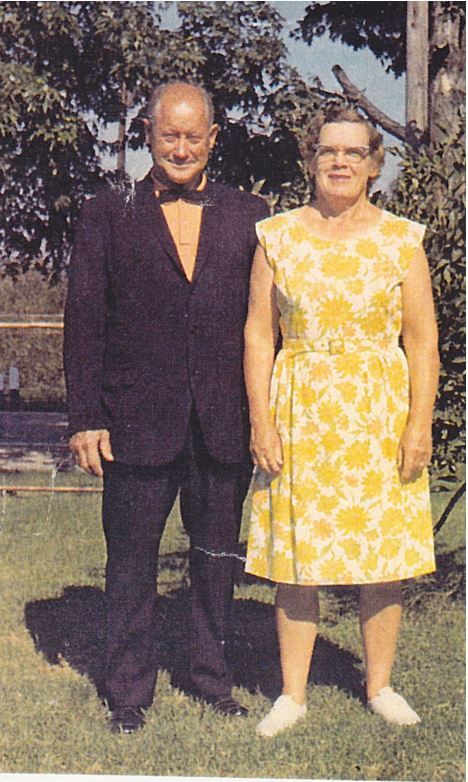
Fig 3-7 – Lora & Rose Pearson in 1969 at age 59 and 56
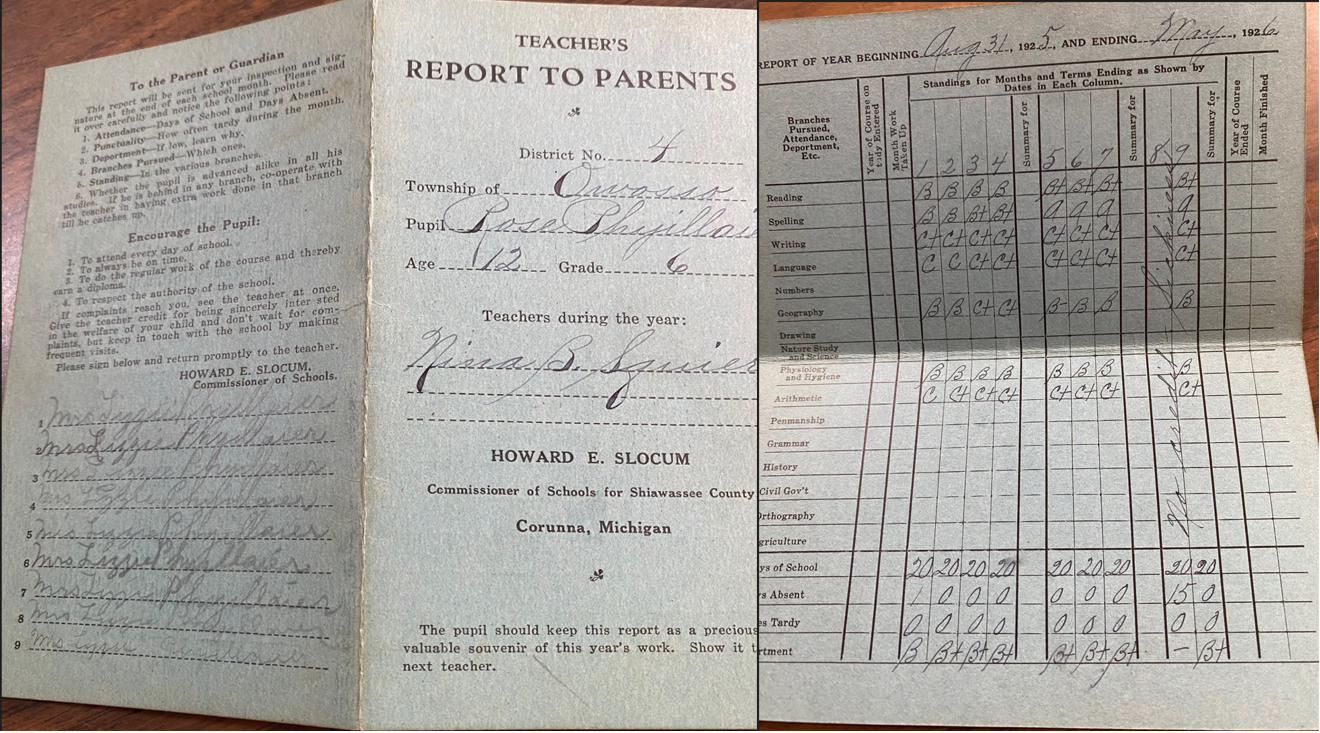
Fig 3-8 – Rose Phyillair report card in 6th grade - 1925
Chapter 4
Lester Earl Pearson (b1888) and Emma Eckerly (b1889)
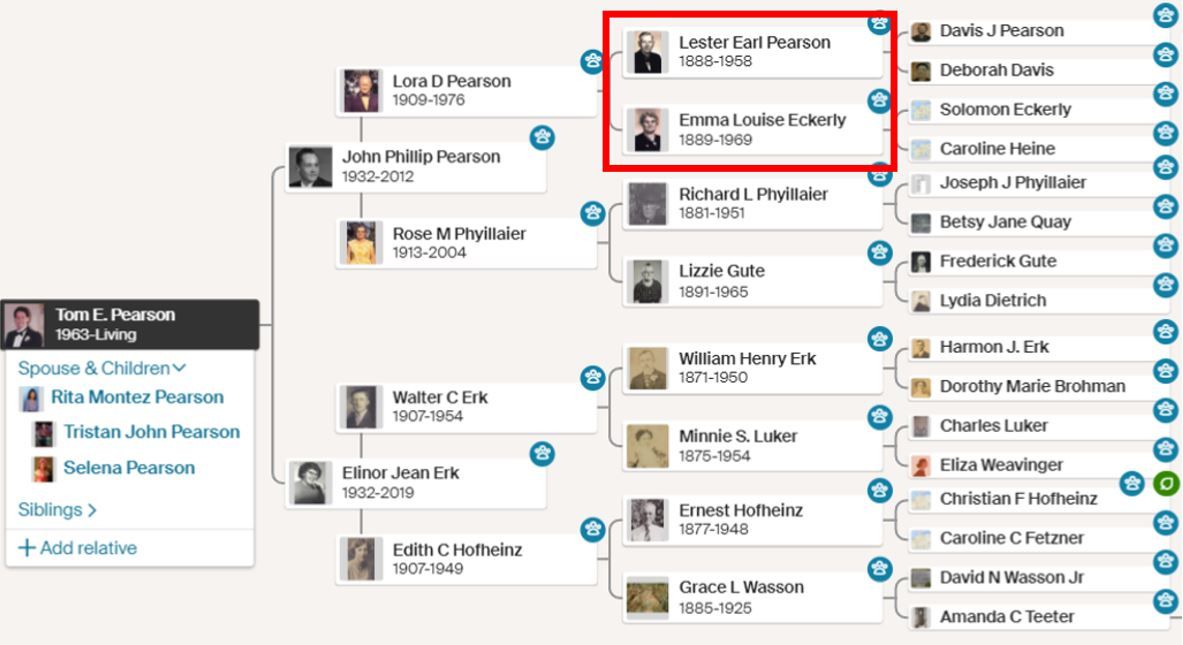
Fig 4-1 – Tom Pearson’s family tree. Red box around Great Grandparents Lester Earl Pearson and Emma Eckerly
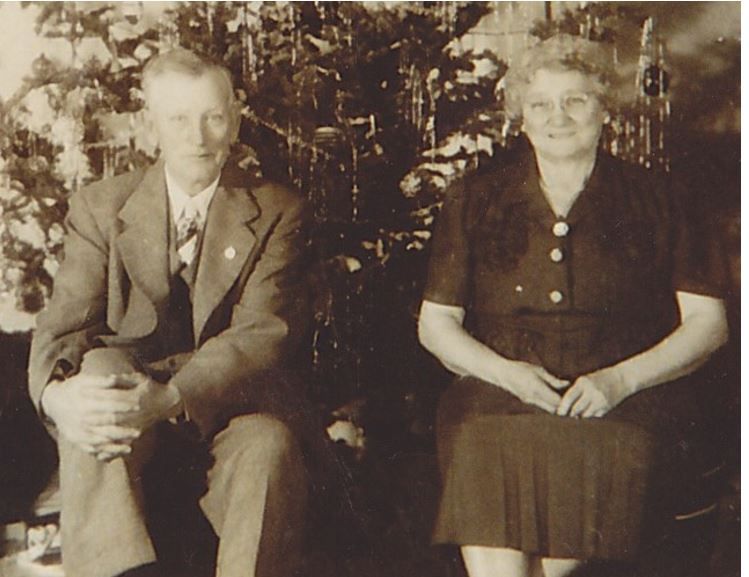
Fig 4-2 – Lester and Emma picture in front of Christmas tree – 1955
Lester Pearson came from a long line of farmers and Quakers in the Miami Valley, Ohio area. Miami Valley is a rural farming area between Dayton, Ohio and Richmond, Indiana with farm supporting towns sprinkled in between. The Pearson paternal bloodline records go back ten generations to 1683 when Thomas Pearson immigrated from Wilmslow, England to Pennsylvania, America to escape persecution as Quakers and to follow his dream of owning his own farm. One hundred and twenty-seven years later, in 1810, Pearson’s migrated to the Miami Valley area after the Treaty at Greenville was signed with native people who lived in the area for thousands of years. Their hopes were to set up farms for themselves and children in the ever-expanding America’s Midwest. Lester Pearson was a decedent of those who migrated to Ohio and the youngest of six children to Davis and Deborah Pearson. They were farmers in the Miami Valley area near Tipp City, Ohio.
Quaker ancestry
When did the Pearson’s leave the “unity” of the Quakers? Lester’s grandparents, Benjamin and Maria Pearson were the last of my ancestors to be buried at a Quaker burial ground. They are buried at the Pearson Cemetery next to the Friends fellowship meeting house (currently called Monroe Grange). Lester and Emma Pearson are buried at the Brush Creek Church of God along with Lester’s parents Davis and Deborah Pearson who also left the unity with the Friends Fellowship (Quakers). Emma’s parents are buried at Maple Hill Cemetery next to the First Baptist Church in Tipp City, Ohio. Her parents were from German ancestry and not likely from a Quaker background.
It is likely the Pearson’s left the Quakers when Davis Pearson married Deborah Davis since they both were the first of my ancestors to be buried outside of Quaker burial grounds. This broke the Quaker unity with my ancestors. It was two hundred years earlier and six generations ago when Lawrence Pearson of Wilmslow, England first joined the Quakers in 1650s.
Lester and Emma Pearson
Lester married Emma when they were 19 & 18 in 1907. They had nine children and the oldest was my grandfather Lora Pearson. Their farm was in rural Monroe township in Miami county located on Fredericksburg Road outside of Tip City, Ohio. He and his family attended Brush Creek Church of God that was just down the road from them. They farmed and traveled with horses until 1920s like all farmers in that time. Lester died when he was 69 in 1958 and Emma in 1969 at age 80.
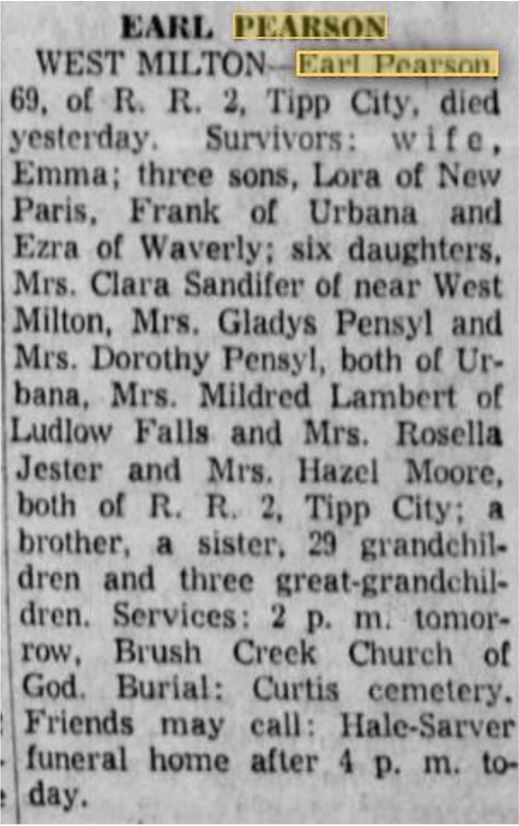
Fig 4-3 - Obituary for Lester Earl Pearson July 17, 1958.
Lora Pearson
Lora Pearson was the oldest child of Lester and Emma and was my grandfather. He married Rose Phyillaier when he was 22 and they bought a farm just south of New Madison, Ohio. I remember Lora vaguely as I was ten years old when he died. Our family use to visit him and my cousins, aunts, and uncles at Christmas. He had a huge glass jar two feet tall of pennies and he would ask the kids to guess how many coins were in the jar and the closest won a prize. Us kids would wonder out into Grampa’s junk yard and explore the old cars and tractors he had collected. He would warn us that there are bear traps out in some of those cars to catch thieves. I am not sure if there was any however it kept us out of the cars. I would think if he did have traps, he would have removed them when the kids were out there.
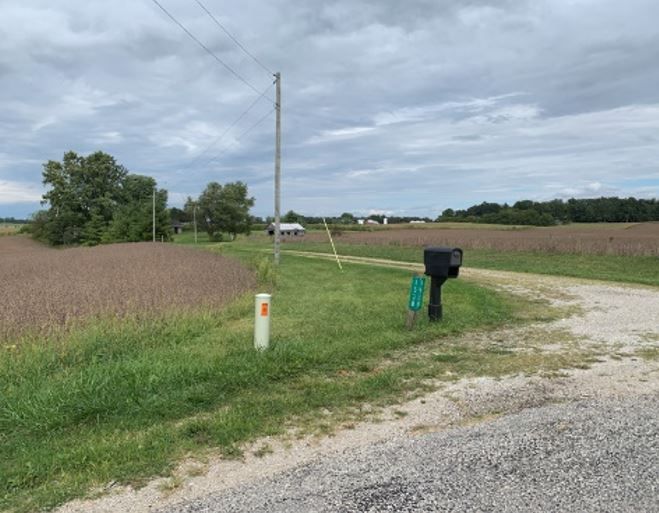
Lora died the winter of 1976. A snowfall brought several inches of snow to the farm and his car got stuck in the driveway of a friend that he was visiting. He was found with the car still running and a shovel next to it. Grandpa never believed in doctors and my dad said he would take a spoonful of castor oil for “whatever ailed him”. In the summer, after he died, we had a huge estate sale. My brother, cousins and I helped get the farm ready for the sale for 2 weeks prior. It was a huge sale and people from all around the community came to it. I look now where the junkyard stood and see big houses surrounding a pond in the field where grandpa had all his junk cars and tractors all those years.
After Lora’s death Grandma Rose moved to Greenville. She got married 5 years later to Marion Schultz in 1981, however he was not well and died 4 years later. Rose lived in Greenville in a small house until she passed away at 90 after heart surgery to help her with the pain of angina. All my cousins on the Pearson side were at the funeral and the celebration of her life.
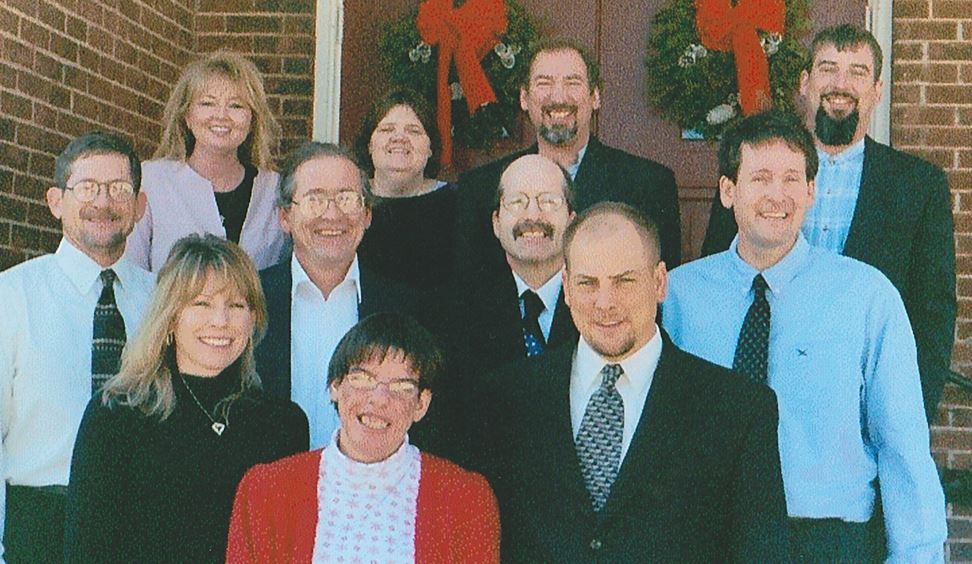
Fig 4-4 – My Pearson cousins in 2004 – Top left to Bottom – Julie and Lisa (Don Pearson), Brad and Scott (June Pearson), Jerry, Terry, Danny, Tom (John Pearson), Kim, Kirk, and Kaleen (Carol Pearson)
John Pearson
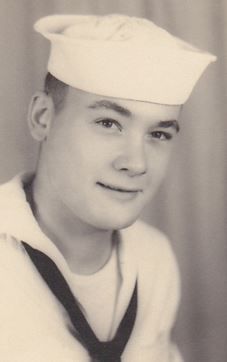
Fig 4-5 – John Pearson navel picture
John Pearson was the oldest son of Lora and Rose Pearson. After the navy he married my mother Elinor and moved onto the farm her father left her after his death. They had 4 sons, Danny, Terry, Jerry, and Tom. His life is best described by the eulogy given to him at his funeral.
John Pearson eulogy by his son Tom E. Pearson 2012
It is an honor for me to speak about the life of John Pearson with his family and friends and to share a little bit about what his life on earth has meant to us.
John was born in the Great Depression in 1932 and was older brother to my Uncle Don, Aunt Carol, and Aunt June. I recently asked Dad what it was like to grow up in the depression. He said “we were poor however didn’t know it. The farm produced most of what we needed, and we wasted nothing.” Growing up in that time created a self-sufficient can-do attitude within John.
Right after he graduated from high school John left the farm and joined the Navy where he learned to be a machinist working with lathes. While in the Navy, he travelled to Japan and saw a world he never knew before and when he came back home was determined to see more of it…a dream that he repeated on two round the world trips with his wife Elinor Jean. When you talk with John, you would know how much he loved those trips and the wonder and surprises that they brought. His adventure stories were told and retold again with the same excitement. John was an explorer and an adventure that played out in the life that he lived.
John was also a caring husband to his wife. When Elinor was diagnosed with a brain tumor and major life saving surgery was needed, John was by her side every step to help her through it. He shut down his business, left a home with young teenage boys and stayed with her at the Indianapolis hospital for a month during recovery. He was the calming force for her when things seem to get out of control and was the most important person in her life here on earth.
Many people in our community know my dad as Dependable John the owner of Pearson Plumbing and Electric that he built and ran for 40 years until he retired. I asked Dad what made him start his own business. He said, “because they told me I would never make it and I wanted to prove them wrong”. Well, he did that and more. In his hay day, John won two consecutive national awards for best year on year growth in a business from Goulds Water Systems. He was proud of these accomplishments however always knew the Lord was the giver and he always thanked Him first when I talked to him about it. My Father was a faithful member of the Whitewater Christian Church for over 55 years where he raised his 4 sons, Danny, Terry, Jerry, and me. It was there that I understood the saving grace of our Lord and it is why I have faith that Dad is rejoicing with Him today.
John was also a Grampa to 11 grandchildren and 8 great grandchildren. Grampa’s farm was always a place where grandkids could go to ride with him on his tractor to the woods, catch lightning bugs in the baseball field, play with him and his old “different toys” on the living room floor or simply to tell Grampa their problems.
Finally, and personally, I would like to share a letter that I wrote my dad in 1994 soon before I became a father myself. It expresses my many thanks to a loving father.
Date: May 1994
Letter to Dad from his son in 1995
Dear Dad,
As I get older, I often think of the many things I was blessed with as a child and now as an adult. One of the biggest blessings is to have you as my loving father. Your life has augmented the values, principles, morals, and faith that I have today. I want to thank you for your commitment and dedication you gave. These seeds were sown long ago, and I know the soil you provided is the reason I can grow today.
I remember the times when I helped you out in the summer between my 3rd and 4th grade with your plumbing work. Summers seem so long when you’re a young child. I remember asking you questions about everything I saw and you answering them the best you knew how. Those summers I felt so close to you as if you were not only my father but also my confidant, my teacher, my best friend. I learned many things about you and myself during those times. I want to thank you for those special moments and for not keeping me at home out from under your feet. I know it would have been easy to overlook me those summers, but you chose not to, you chose to spend it with me.
I remember taking many trips with you in my early teenage years. We went to water well trade conventions together passing through different states and in return you showed me our world and how to explore beyond what I know. On one trip to Las Vegas, you took me to Death Valley where we got stuck in a rock wash out on the road and stayed the night stranded in our truck camper while we waited for rescue. On another trip to New Orleans, you took me to my first NBA basketball game in the amazing new Super Dome. And on another extraordinary trip with Grandma, you took us to England and helped me collect foreign beer cans for my beer can collection.
Our bonds grew when we went on our camping trips and cross-country adventures and when we explored craters in the southwest and “dry” deserts that were not so dry. It was nurtured when we went on our weeklong canoe trip with the Boy Scouts, and it got exciting when you cheered me on at my high school basketball games. The fun, laughter and adventure will always be remembered because you made it happen. You committed to being my father. You dedicated yourself to be a special part of my life. These things I will always remember of you.
There are many instances in my childhood I remember and many examples I have that shows how your life has touched mine. The important thing is that my childhood was not about insecurity, abandonment, carelessness, or abuse. Instead, it was about commitment, dedication, values, and love. For all these reasons, I thank you from deep inside my heart.
You’re loving son,
Tom
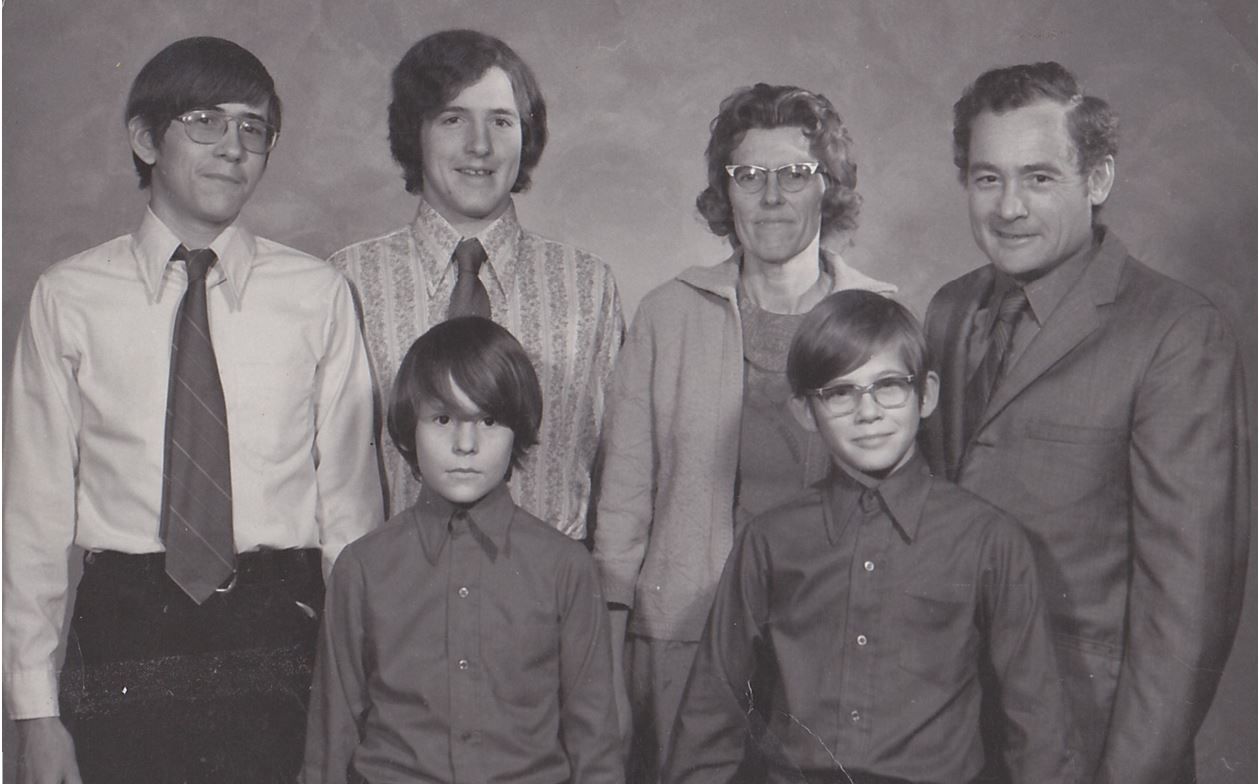
Fig. 4-6 – John and Elinor Pearson family – Danny, Terry, Jerry, Tom
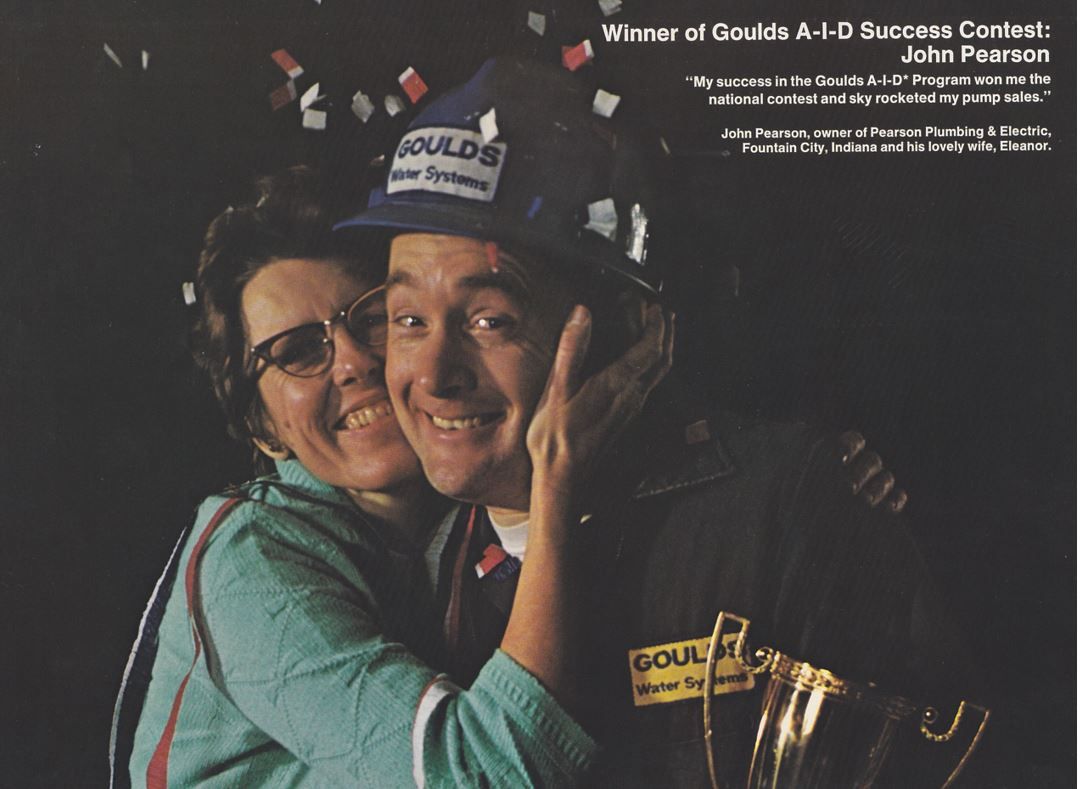
Fig. 4-7 – John’s and Elinor’s award-winning picture 1975
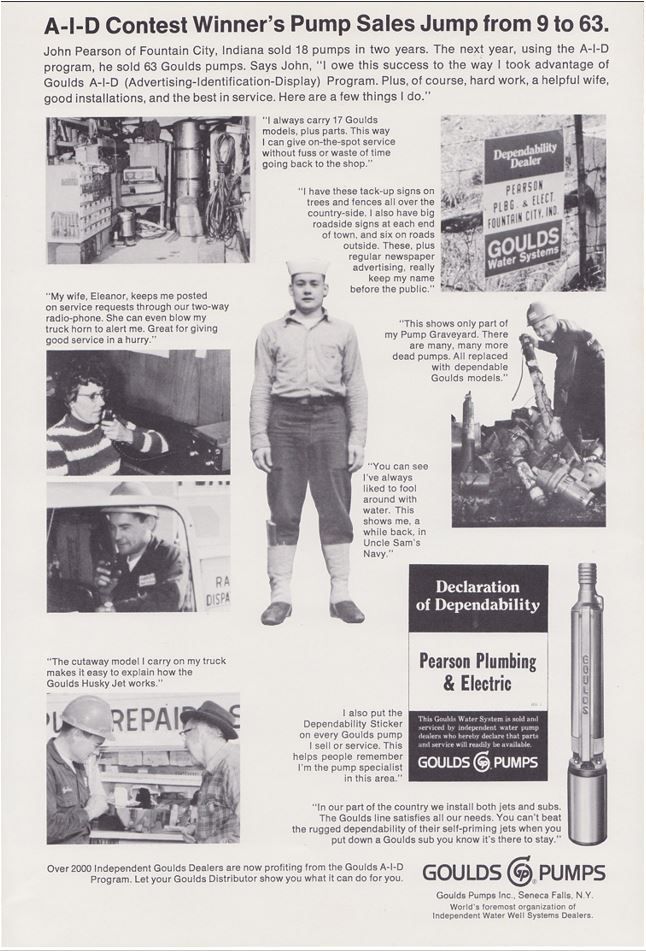
Fig. 4-8 – Pearson Plumbing and Electric business John had for over 40 years.
Tom Pearson
Tom Pearson is the youngest of four sons of Elinor and John Pearson. In Tom’s childhood he loved to play basketball and often played at the Whitewater School outside courts. He went on to play throughout his high school years. After he graduated from Northeastern High school, Tom attended ITT Technical Institute and studied Electronics and Automated Manufacturing. He earned an associate degree in Electronics Engineering Technology in Dayton, Ohio and a bachelor’s degree in Automated Manufacturing Technology in Indianapolis, Indiana.
After college, he moved to Shreveport, Louisiana and worked at AT&T phone manufacturing company for 5 years. There he troubleshooted and repaired telephone test and manufacturing equipment and played softball in his spare time. Then he moved to Houston, Texas where two years later met his wife Rita Montez on a company ski trip to Winter Park, Colorado. Tom worked at Compaq Computers for six years as a Manufacturing Engineer developing advanced automated placement equipment for computer board manufacturing before moving to Oregon with his wife.
Tom married Rita Montez in Houston, Texas at the age of 29 and they traveled to Australia and New Zealand on their honeymoon. In New Zealand, Rita and Tom loved the beauty of the rolling green hills, snowcapped mountains, and rugged shorelines of South Island New Zealand and wanted to live and raise a family in such a place. Tom and Rita made that dream happen three years later when they moved to Portland, Oregon. Tom worked at Intel Corporation as a Technology Development Engineer and raised his family in the Northwest United States. At Intel, Tom was an engineer and prolific inventor with 30 patents on various products, technology, and manufacturing processes. In 2015, Tom worked for Hewlett Packard as Director of Engineering. Tom and Rita Pearson have two children, Tristan, and Selena, and still lives in Oregon.
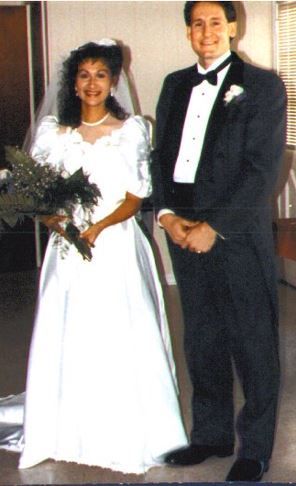
Fig. 4-9 – Tom and Rita Pearson’s wedding picture in Cypress, Texas
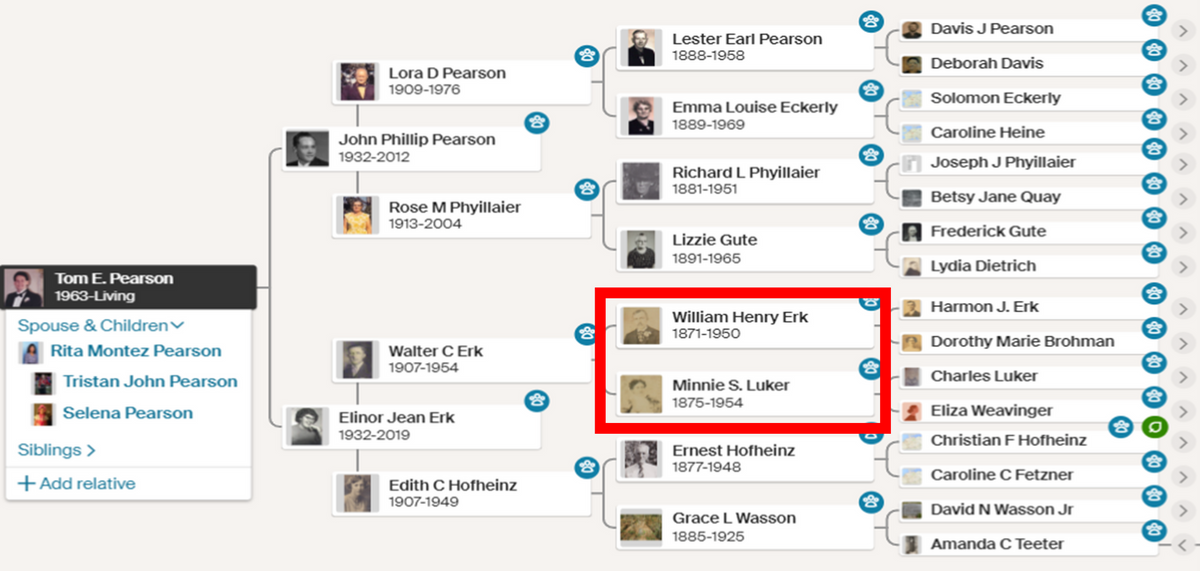
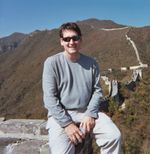
Member discussion: